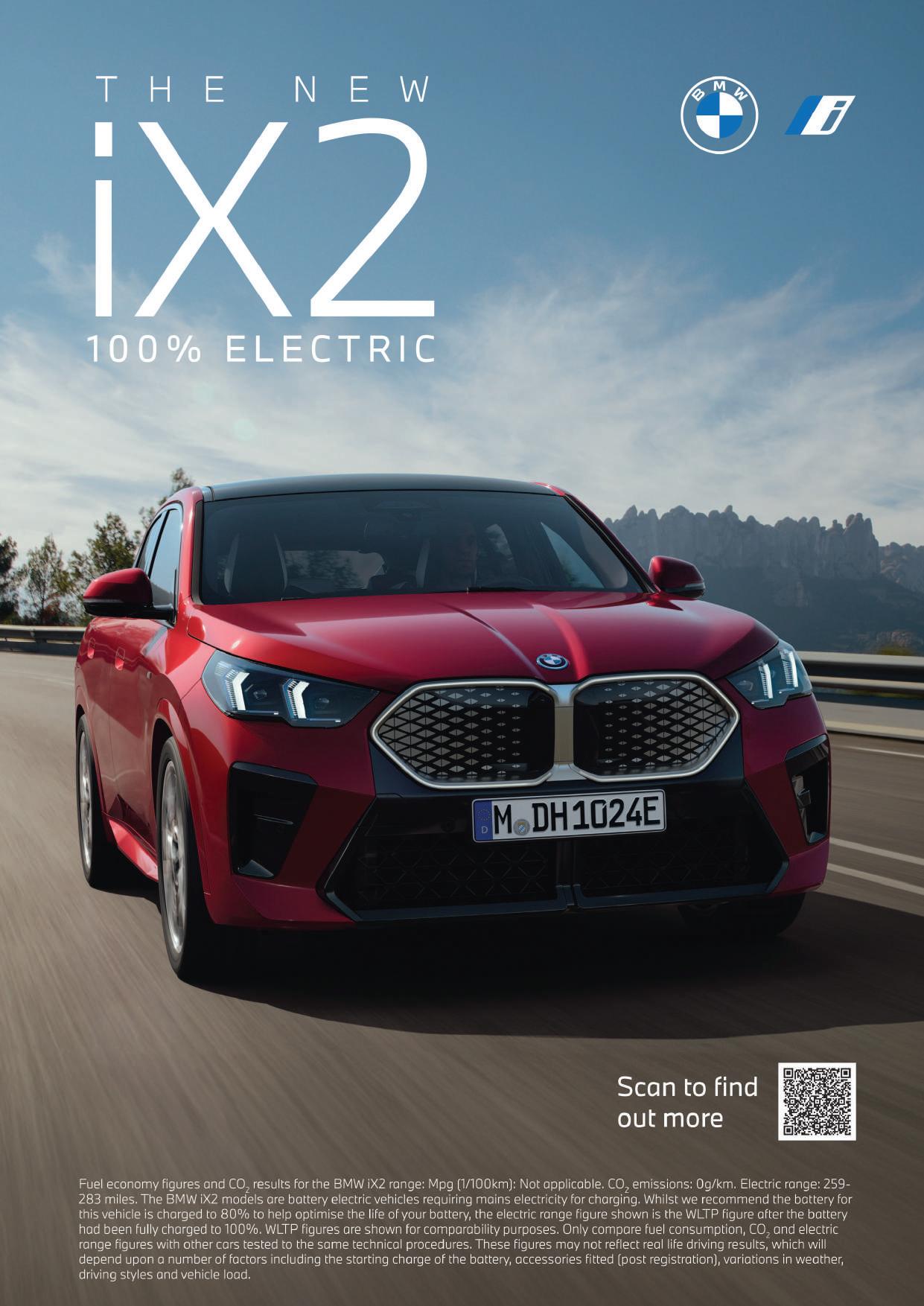








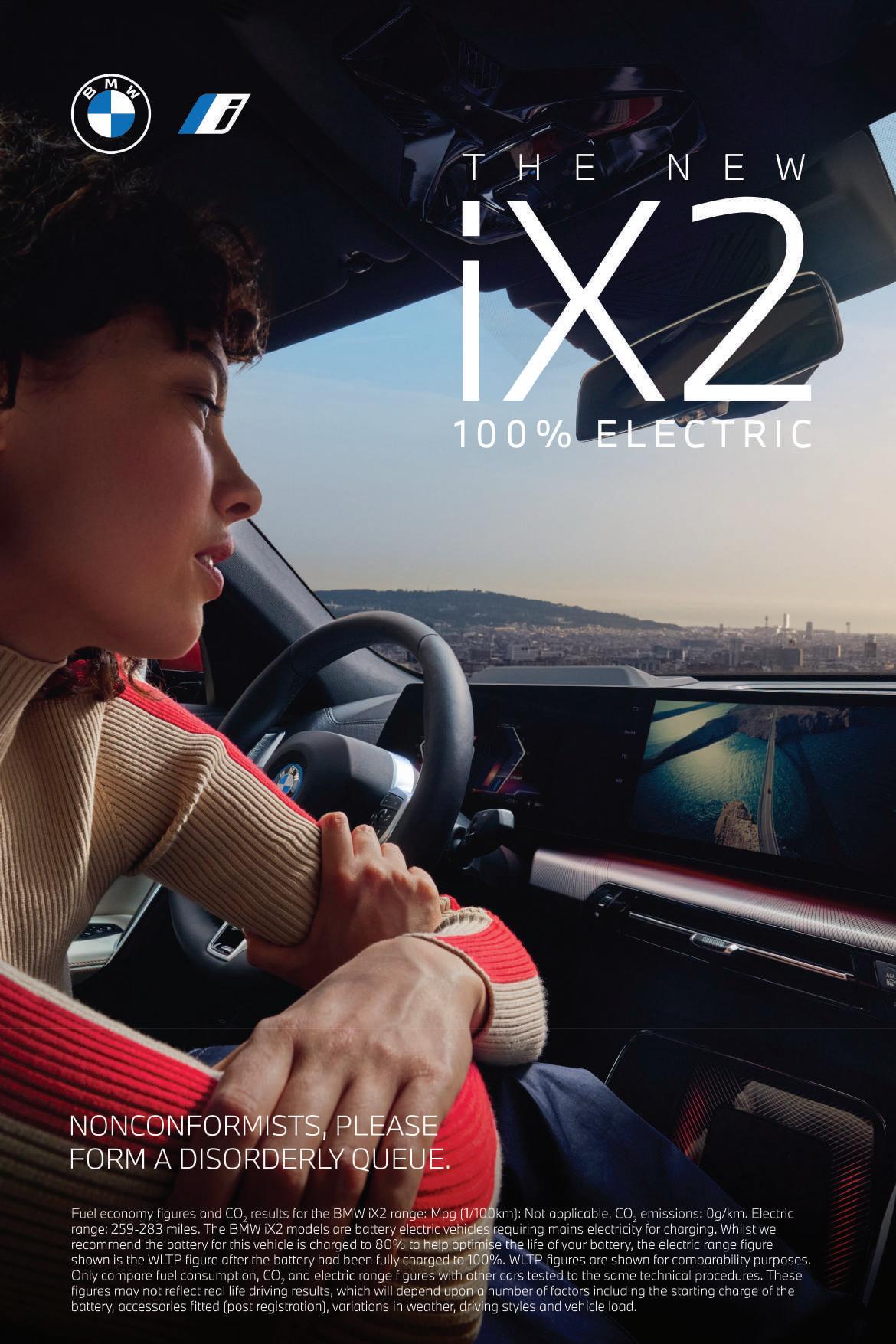
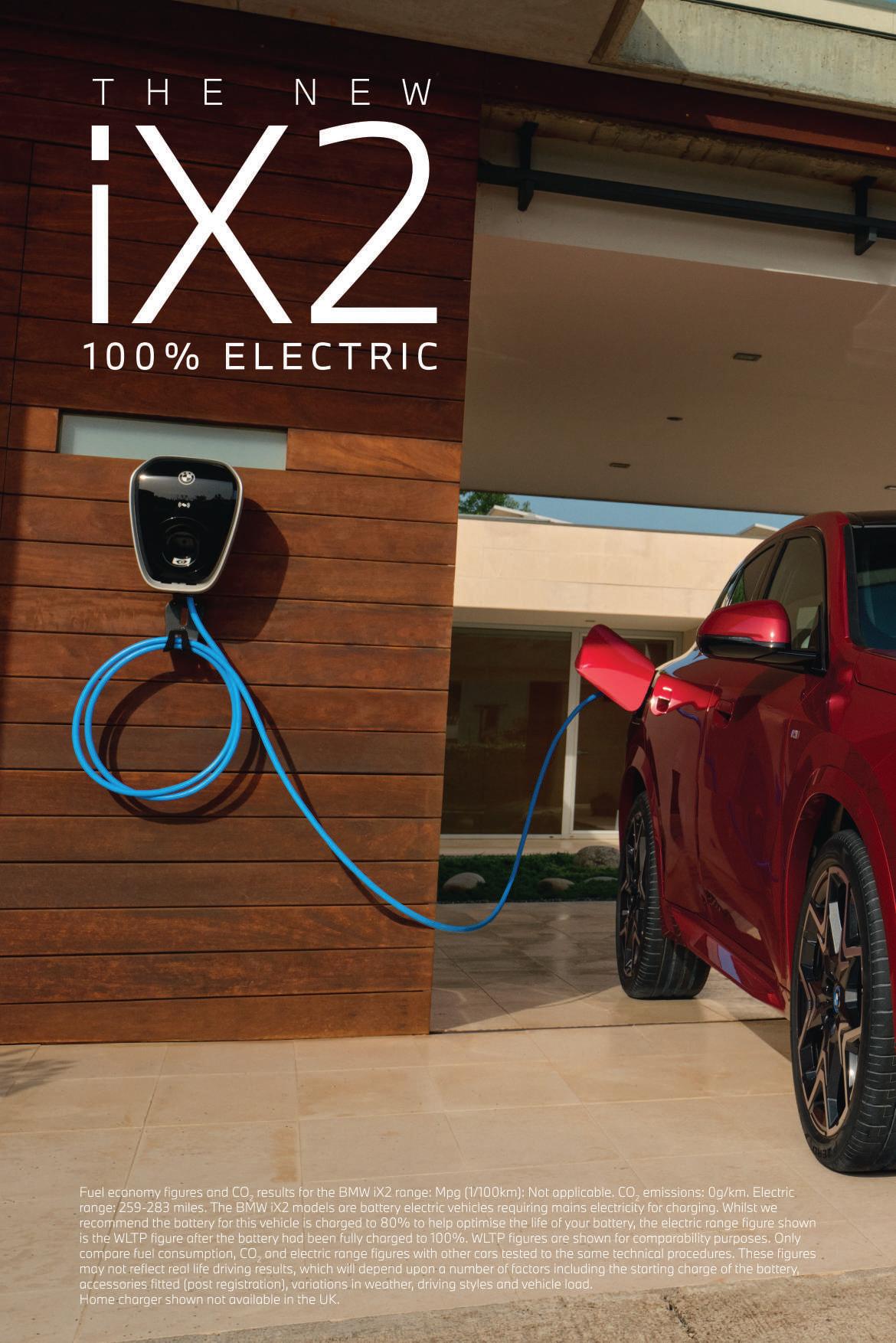
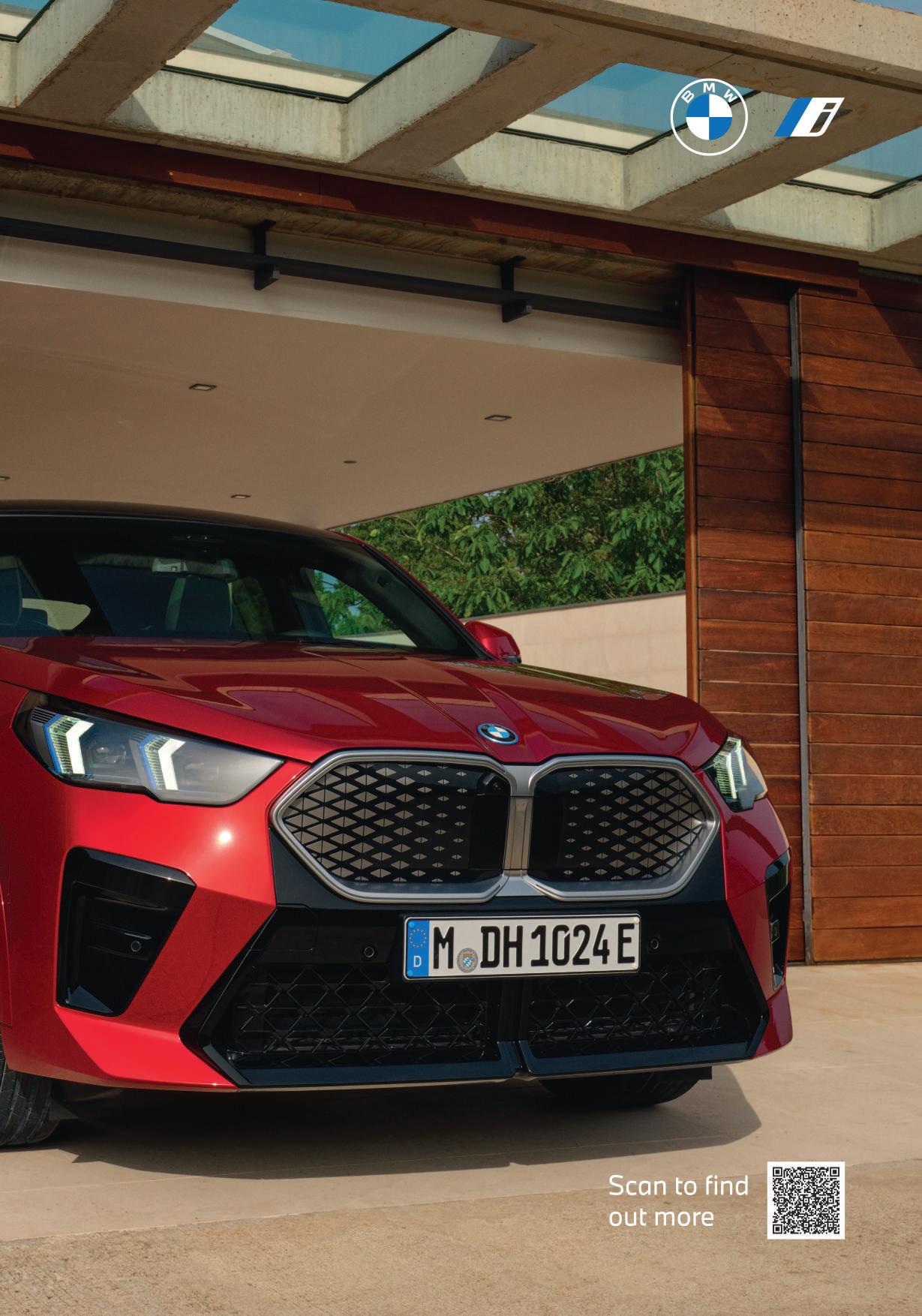


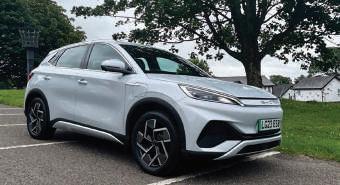


After a quiet January, things took off from February onwards with CC&V attending several new vehicle launches, including the BMW iX2 and Maxus eDeliver 7, both electric and both after your business.
We begin with this issue’s cover star, the BMW iX2, which was launched alongside the all-new Mini Countryman. BMW is electrifying its model range at pace – the Countryman will add an EV version later this year – so to find out a little more about their plans for fleet, we sat down with Matt Collins General Manager of Corporate Sales for a chat. You can read our Q & A inside.
Our electric focus comes via BVRLA which, alongside a coalition of industry experts and trade bodies, has launched the ‘Zero Emission Van Plan.’ Over three million people are at risk of falling behind in the UK’s zero- emission journey unless the Government takes immediate steps to support the transition to electric vans. The coalition travelled to Parliament to highlight the action needed.
Keeping the emphasis on electric, regulars Rolec and Sevadis highlight their charging offerings, while Mobilize launches its Fleet@ Home proposition which will help fleets calculate the true cost of EV running and ensure fleet drivers can charge at the most convenient and relevant sites.
Northgate Vehicle Hire focuses on EV rental, Vanaways and the lcv group discuss electric leasing van offerings and My Car Direct explains how its short-term vehicle leases are as flexible as you want them to be.
In February’s issue we waxed lyrical about the BYD Seal, an electric performance saloon to compete with Tesla. BYD has already launched two other models and this time we review the ATTO 3, a mid-sized electric SUV that’s decidedly different inside.
Toyota has completely refreshed its bestselling C-HR, with a plug-in hybrid version set to land in mid-2024. We spent a week in the self-charging hybrid and found that it hasn’t lost any of its appeal.
JLR has updated its plug-in hybrids to make them even more appealing. We take a look at the Jaguar F Pace and Range Rover Evoque PHEVs, both of which are BIK friendly. A trip to Liverpool saw us catch up with the Maxus eDeliver 7, the Chinese brand’s first medium electric van. In 2023, only Vauxhall sold more electric commercials than Maxus and arguably, the mediumsized sector is the biggest, so an electric competitor seems sure to do well. We came away impressed.
Pick-ups are also on the agenda. Isuzu has tweaked its D-Max range and we test the range topping V-Cross this month. Volkswagen has a new Amarok to shout about, and it’s really rather nice.
Elsewhere in vans, Ford has launched a new Courier which we take a closer look at, and Nissan’s small Townstar takes centre stage as we negotiate the streets of Greater Manchester. The Toyota Proace City is the Japanese brand’s small electric van and comes with a 171-mile range. We drove one for a week and found out that for local tradespeople, it could be ideal.
Andrew Walker, Editor and Publisher
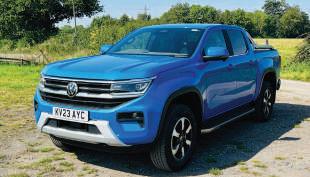

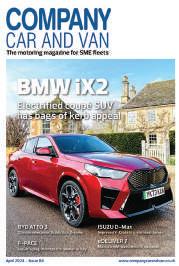
The choice between diesel and electric vans has become a critical decision for businesses. Both options offer unique advantages and challenges, making it important to weigh the factors that impact leasing vans for business.
The impending ban on diesel and petrol vans in 2035, coupled with the expansion of clean air zones across the UK, has spurred a growing interest in electric vehicles (EVs) among consumers. This shift has led manufacturers to diversify their EV offerings, reflecting a broader trend in the automotive industry. Businesses are re-evaluating their fleet choices to align with sustainability goals as environmental concerns take centre stage.
One of the primary driving factors behind the surge in electric van sales is the significant cost savings they can offer over their traditional combustion engine counterparts. Lower maintenance costs, coupled with increasingly competitive prices for electric vans, make them an attractive investment. Additionally, businesses can access Government grants, encouraging more businesses to make the switch.

Range and battery technology:
The most common concern with EVs is their range, and accessing charging points on the road. But range anxiety has been largely alleviated with advancements in battery technology and the expansion of charging infrastructure. Lithium-Ion batteries, the most common type used in electric vehicles, boast higher energy-to-weight ratios and low self-discharge levels, resulting in better energy storage and longer-lasting charge, meaning you get more out of a single journey.
Charging infrastructure
Access to a reliable and widespread charging network is crucial for electric van fleets to minimise downtime and ensure efficient operations.
Rapid charging facilities enable quick turnarounds, enhancing productivity, while strategic route planning helps mitigate range anxiety and maximise vehicle utilisation. A robust charging infrastructure fosters confidence among businesses looking to transition to electric fleets, aligning with
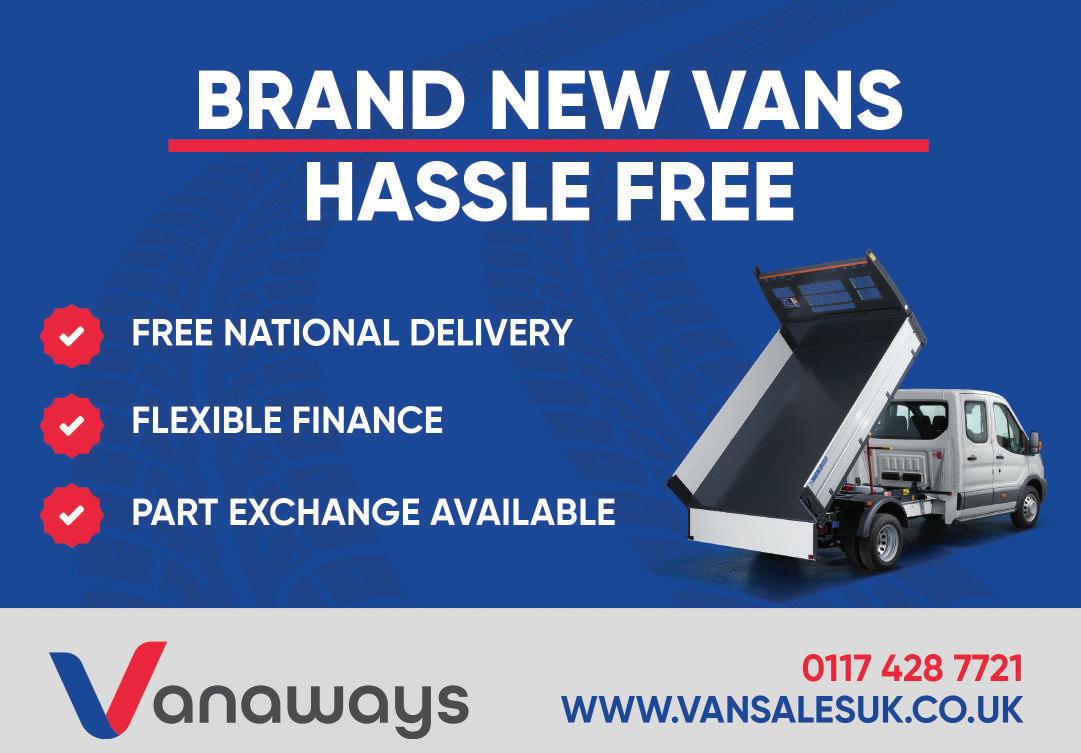
“The end of January saw a total of 55,301 charging points across the UK, which is a 46% increase since January 2023”
environmental goals, driving innovation towards a greener future.
In Zapmap’s EV charging statistics 2024, the end of January saw a total of 55,301 charging points across the UK which is a 46% increase since January 2023.
Government incentives and grants:
Despite EVs higher upfront costs, the long-term savings from reduced fuel and maintenance makes them financially appealing. The UK Government’s grant on low-emission and electric vehicles can significantly offset initial purchase costs, making the transition to electric fleets more accessible and cost-effective.
Small Vans – 35% of the purchase (maximum contribution of £2,500) for small vans with a gross weight of less than 2500kg and produce less than 50g per km of CO2 emissions. The vehicle must also be able to travel at least 60 miles without producing any emissions.
Large Vans – 35% of the purchase price (maximum contribution of £5,000) for large vans with a gross weight between 25004250kg and produce less than 50g per km of CO2 emissions. The vehicle must also be able to travel at least 60 miles without producing any emissions. Additional grants are also available for the installation of business charging points.
Environmental impact and sustainability:
Electric vans play a crucial role in reducing greenhouse gas emissions and improving air quality. While not entirely carbon-neutral due to manufacturing processes, electric vans offer zero-exhaust emissions during operation, contributing to a significant reduction in a business’s overall carbon footprint.
Governmental departments and local institutions are taking a favourable approach to sustainability to mitigate their environmental impact and to combat climate change.
VANAWAYS – YOUR ELECTRIC VAN EXPERT
Choosing electric vans not only aligns with environmental responsibility but also reflects a commitment to meeting consumer demand for sustainable products and services.
At Vanaways, we help businesses with acquiring electric vans tailored to their specific needs, ensuring a hassle-free transition to sustainable transportation solutions.
Our expertise and personalised approach help businesses navigate the complexities of electric vehicle adoption, assessing whether it’s right for your business needs, enabling you to reap the benefits of lower operating costs and reduced environmental impact.
Give Vanaways a call on 0117 428 7721 or email info@vanaways.co.uk
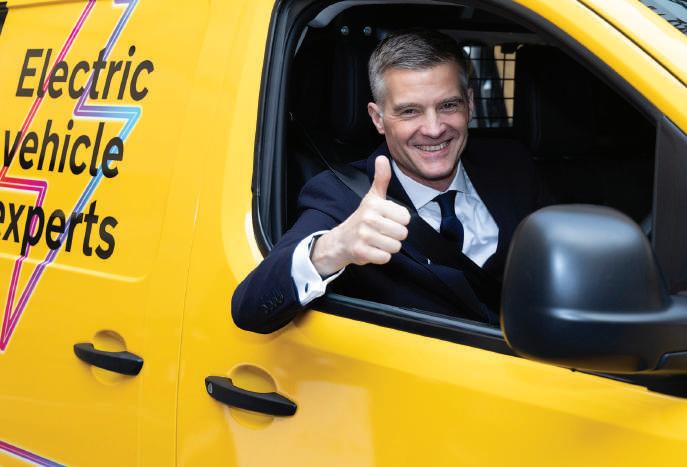
Over three million people are at risk of falling behind in the UK’s zero-emission journey, unless the Government takes immediate steps to support the transition to electric vans.
That is according to a coalition of industry experts and trade bodies, who have launched the ‘Zero Emission Van Plan’ to highlight where action is needed.
The launch took place in the Houses of Parliament on Tuesday, 20 February. It saw representatives from across the coalition talking to MPs about the sector and where they can bring positive change.
MPs from the top four parties joined to pledge their suppor, including Transport Secretary Mark Harper, the Chair of the Transport Select Committee, and four members of the shadow cabinet.
Key asks and recommendations underpin the Plan, split into factors that impact affordability, vehicle charging, and regulations. As the fastest growing part of the UK’s vehicle parc, vans account for more miles being driven on our roads every year. They are used nationwide across every industry, from engineering and construction to logistics and emergency services. Vans are an essential form of transport and a mobile workspace for 3.4 million drivers.
Brought together by the BVRLA, the coalition involves Logistics UK, Recharge UK, the AFP, and The EV Café. All partners have contributed to the content of the Van Plan and will be collaborating on activities through 2024 to share its recommendations with decision makers.
Commenting on the launch of the Van
Plan, BVRLA Chief Executive, Gerry Keaney said: “Vans are the backbone of our economy, providing an essential form of transport and a mobile workspace. They are growing in number every year and account for a major portion of the miles driven up and down the country.
“If the UK is to meet its road decarbonisation targets, zero-emission vans must take centre stage. They are a vital player in the transition and deserve more attention.”
David Wells, Chief Executive of Logistics UK said: “The logistics sector remains fully committed to decarbonising and has already made significant progress to do so. However, to deliver a fair transition to a green economy that keeps costs down for customers and goods moving from A to B, van operators need meaningful support.
“That means ensuring public chargepoints are accessible to commercial vehicles, removing regulatory barriers from and improving fiscal support for going electric, and tackling barriers with energy supplies. ”
Those working in the fleet sector are being encouraged to support the Plan. A simple online tool allows individuals to quickly send it to their local MP to raise awareness, while fleet operators can also complete a very short online poll to strengthen the data the coalition is putting to decision makers.
The full Zero Emission Van Plan can be viewed at bvrla.co.uk/vanplan
Championed as one of the most progressive cities in the UK (and one of the largest), Edinburgh is home to more than 500,000 constituents and an impressive EV fleet of over 150 decarbonised cars, vans, and buses for the dedicated use of the council.
The council has no plans to slow down its shift to carbon-free motoring anytime soon either, and has dedicated itself to becoming a completely Net Zero city in the next six years.
Scope
Thanks to funding from Zero Waste Scotland, the council will be welcoming new electric refuse collection vehicles (eRCVs) as part of its goal to electrify the council’s entire fleet by the end of 2024. The new 20-tonne vehicles will help the city to expand its recycling facilities and better support constituents’ needs.
To support the growth of their EV fleet, the council felt the need to expand its chargepoint network and came to Rolec to devise a plan. New vehicles mean new charging requirements, specifically in this case as the council was looking for ultra-rapid chargers with the scope to deliver charge to these larger vehicles.
The chargers also had to account for the difference in vehicle height and dimensions and therefore needed to be fit with longer than standard cables. Furthermore, with the ever-growing nature of their EV fleet, the council also prioritised chargepoints that could be scaled-up as and when the need arose.
Rolec’s solution
Rolec provided Edinburgh City Council with 10 x 80kW UltraCharge 160 chargepoints, each with extended 7m cables and capable of being upgraded to up to 160kW at a later date.
This created a robust and scalable charging network capable of handling the needs of these larger EVs.

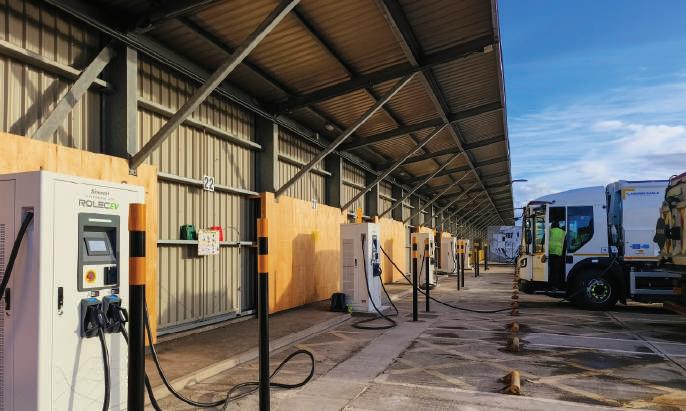
Organisation involved: Edinburgh City Council
Partners:
■ Rolec EV
■ Monta
■ Phase UK
Industries:
■ Public Sector
■ Waste Management
The new package is backed up by an extended hardware warranty provided by Rolec.
The council also opted for OCPP 1.6-J hardware to allow even more freedom in its back-office. This gave the council the opportunity to trial Monta’s software, with the capacity to revert back to ChargePlace Scotland if they wish in the future.

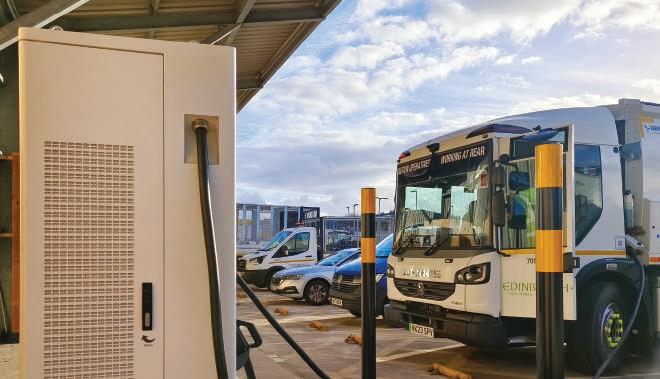


Rolec EV Products:
■ 10 x 80kW UltraCharge 160 ultra-rapid chargepoints
Benefits:
■ Permanent installation of an ultrarapid vehicle charging network to support EV fleet expansion
■ EV hardware reinforces the council’s green initiatives, specifically the rollout of extended recycling measures
The EV hardware provided by Rolec means the council will be able to meet its environmental aims on two fronts: delivering expanded recycling services to their constituents and cutting fleet carbon emissions at the same time.
“We are forever encouraged by local councils who put sustainability at the forefront of what they do, and Edinburgh City Council is no exception,” said Josh Holstead, Business Development Manager, Rolec EV.
“Its continued focus on reducing carbon emissions through advanced policy changes and a passion for fleet electrification has defined this project.
“It was a pleasure to work with the team and we look forward to seeing their continued development.”
For more information:
Contact Josh Holstead, Rolec’s fleet project lead, at: Josh@rolecserv.co.uk or visit the website: rolecserv.com to view the full product range.
Alternatively, call the team at 01205 724 754.
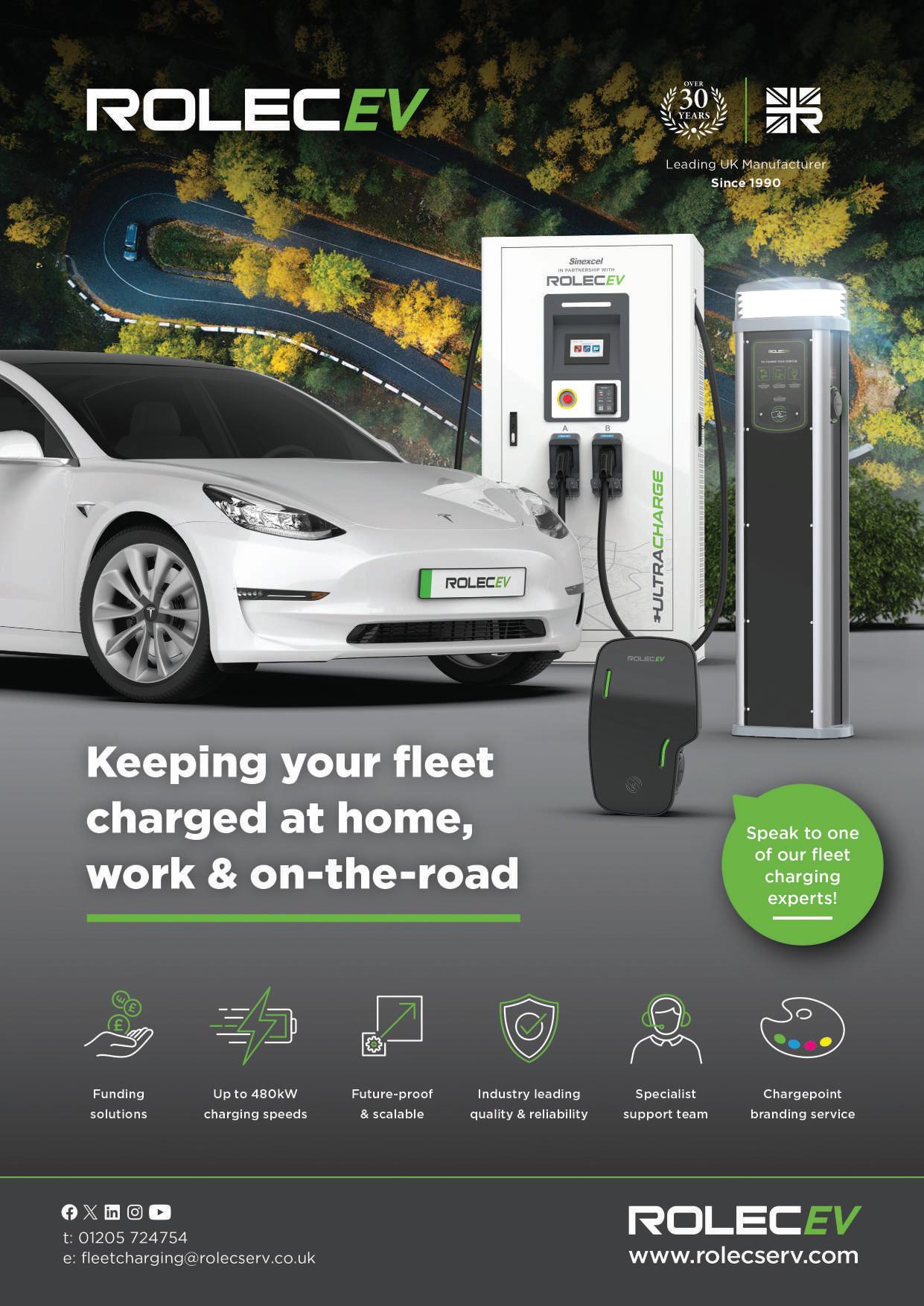
Mobilize Power Solutions is committed to simplifying charging for business drivers. The company has developed an ecosystem promoting ‘charging everywhere,’ ensuring drivers have access to charging facilities at home, en route, and at the workplace, thus extending vehicle range and eliminating concerns about running out of charge. Both these are vital issues for businesses considering the switch to EVs.
Enhancing the UK infrastructure with private charging networks
With up to four million private commercial parking spaces available, installing private chargepoint networks is critical to the expansion of the UK’s charging infrastructure.
Moreover, opening up private networks to the public can generate revenue and ensure a return on investment for the business.
Earn money from your workplace charge points
Monetising charge points is a viable option for many businesses. Profitability depends on factors such as location, accessibility, and pricing strategy.
Mobilize Power Solutions offers expertise in determining optimal pricing models and
conducting site and fleet assessments to maximise profitability. It also installs charge points that offer easy payment and reporting options.
Make home charging fair for the business driver
Home charging presents the most convenient and cost-effective option for EV owners, but separating business and personal expenses can be challenging.
Mobilize Power Solutions addresses this with Fleet@Home, an integrated solution that tracks business miles and electricity consumption. Supported by its management software platform, Mobilize Manager, energy consumption and costs accumulated in the home charging network are monitored so that the whole fleets’ running costs can be calculated.
The ‘inbetweeners’
Over a five-day week, a typical delivery driver travels 20,000 - 50,000 miles a year. That’s 83 - 208 miles a day, so even if their vehicle is fully charged at the start of the day, some drivers will need to charge en route.
These ‘in-between’ charges are also part of Mobilize Power Solutions ‘Charge
Everywhere’ proposition.
Accessed via the Mobilize Go app, drivers have access to over 27,000 nationwide public charge points on its network, with charging sessions activated using an RFID card or the app itself, with the cost and session time recorded within the management platform.
The three-pronged solution from Mobilize Power Solutions enables drivers to charge at home, on the road and at the workplace. A fleet manager can also view and monitor the whole charging network used by its drivers on one system so that fleet charging is optimised.
Implementing a comprehensive charging strategy that can be managed via one platform, helps organisations efficiently charge their electric fleets while maximising operational efficiency and minimising cost.
For more information about how Mobilize Power Solutions helps make electric mobility accessible and practical for business drivers and fleets, contact: business@mobilize.com or visit: www.mobilize-power-solutions.uk.
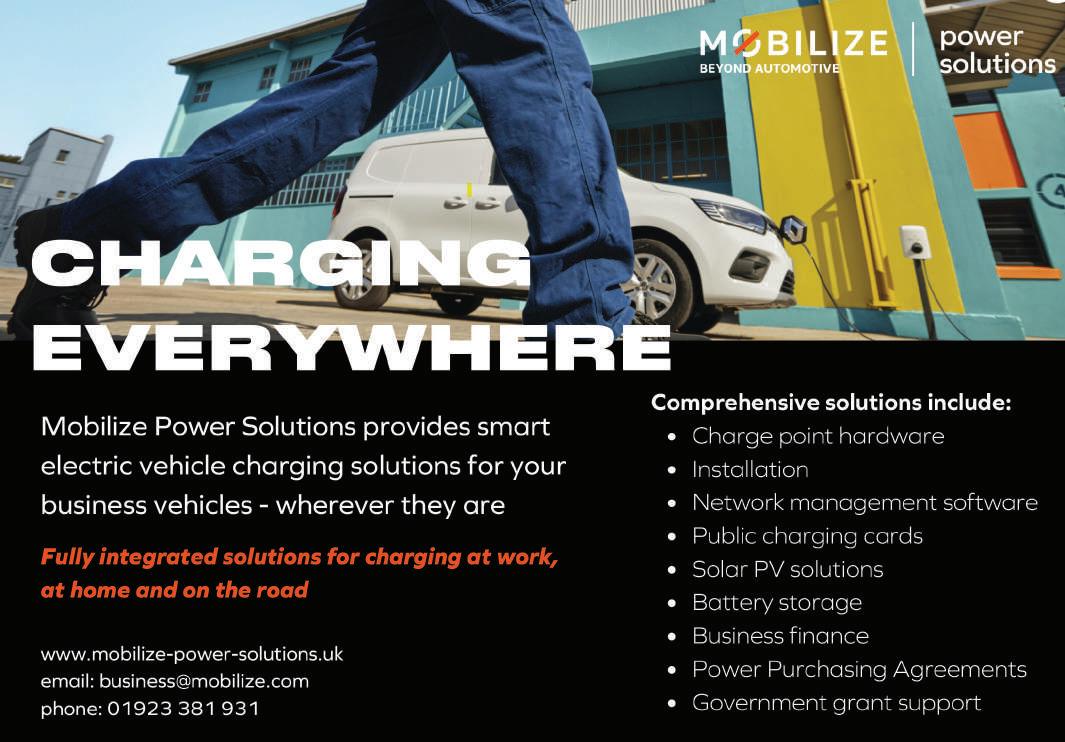

Oliver Sutherland has been appointed as the lcv group’s new Business Development Manager – the first in the group’s history, in a role that was created specifically with Oliver’s skills in mind.
Bringing a wealth of experience and enthusiasm to the position, Oliver joined the company in 2016 fresh out of college. He learnt the ropes via stints in remarketing, contracts and deliveries, and when his first taste of sales arrived he took to it “like a duck to water”, excelling at finding customers the best deals for their needs.
Reflecting on his early apprenticeship with the company, Oliver recalls that: “I learned a lot about how things work, and everything snowballed from there.”
He is now looking forward to taking things to the next level by providing businesses with larger fleets an extra level of service and, crucially, saving them even more money.
“This new position allows us wider scope,” he explains.
“If bigger companies haven’t got anyone dedicated to fleet management, they might need more assistance. I’m here to help with those fleet services and to save the director time and money.”
For Oliver, it’s more than just a sales and customer relationship. He sees it as a partnership, spending the time to develop a greater insight and understanding into what

makes each business tick.
“They aren’t just customers, they’re partners,” he says.
“We want to have that personal fleet manager relationship with our partners. We free up their staff to get on with what they do best, while we do what we do best.”
This is an attitude that has run through the lcv group since it was established in 1999 by CEO Rod Lloyd, who Oliver credits with helping to guide his career: “When I first came into the team in 2016, he made a point of saying to me: ‘you’re a part of our team, and you’re a part of the family now.’ He might be the head honcho, as it were, but I can have these conversations with him, and it’s nice to
“It’s more than just a sales and customer relationship... it’s a partnership, spending the time to develop a greater insight and understanding into what makes each business tick.”Oliver Sutherland (left)
know that I’m coming into this new position with his full support.”
Looking to the future, when Oliver isn’t relaxing on the golf course, he will continue to push himself to greater heights, which he sees a win-win situation for all involved:
“I’ve always put a lot of pressure on myself to get results, to be the best for myself and for my partners. They know when they phone me they’ll get a fantastic service.”
“They are benefiting from that hard work, and you can see this on the testimonials on the website, which are honest reviews for very happy people. I find that the most rewarding part, knowing that I have done a good job for them.”
To book and appointment with Oliver email oliver@thelcvgroup.co.uk or ring 01792 818538.
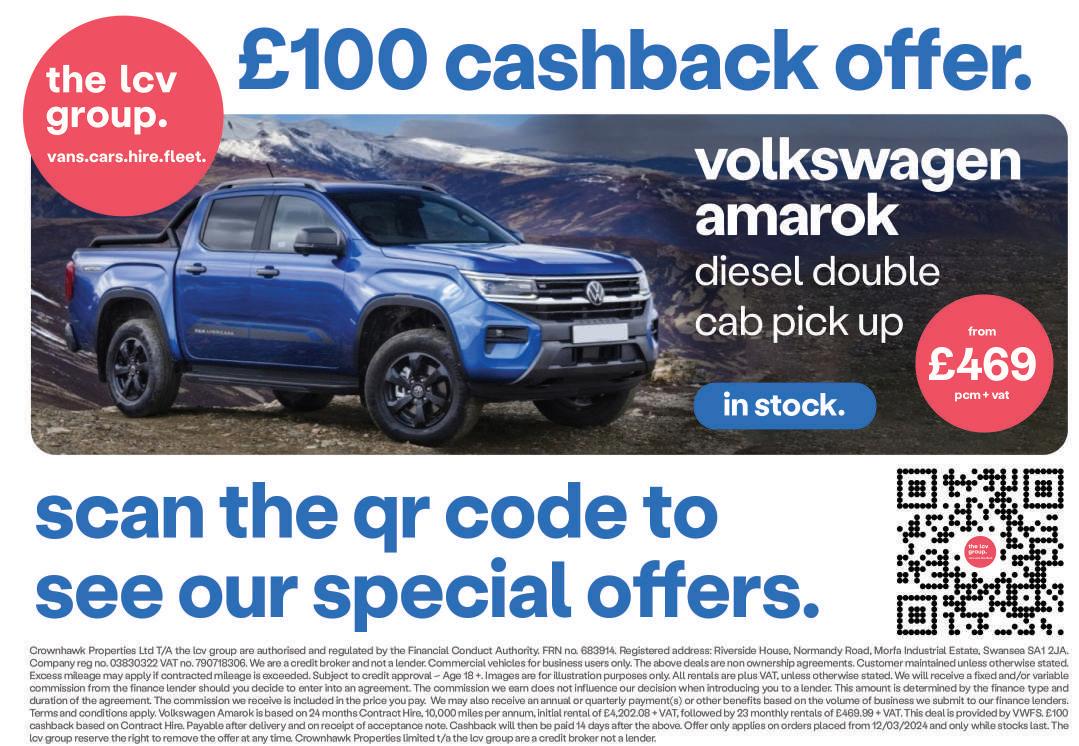
BAM’s state-of-the-art eco headquarters in Kilsyth has a range of Sevadis EV charging solutions.
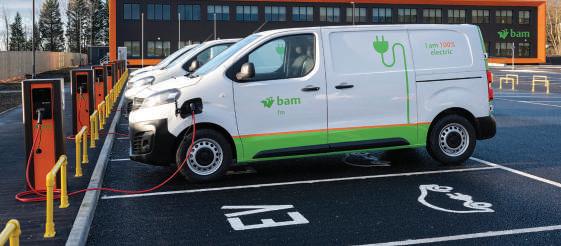
Sevadis, the provider of one of the UK’s most reliable electric vehicle (EV) chargepoints, is joining forces with BAM Charging Solutions to form a powerhouse collaboration to support the future of electrification.
The partnership is set to provide seamless AC and DC charging solutions to BAM’s existing and prospective customers, expand Sevadis network of EV charging points and reinforce businesses’ pathways to net-zero objectives.
As part of the BAM’s wider sustainability plan, it has recently built a brand new state-of-the-art eco headquarters in Kilsyth, near Glasgow. This has been completed with a range of Sevadis EV charging solutions. They opted for 32 MaxiChargers with LCD screens in 16 custom pillars with contactless card readers. These provide drivers with convenient charging sessions that can be activated without the requirement of an app.
Additionally, a 100kW MaxiCharger DC Fast charging station was also deployed on-site to enable rapid charging. This can get an EV up to 80% battery in 30 minutes or less.
By combining their expertise and resources, the two leading companies, Sevadis and BAM Charging Solutions are set to make a substantial impact on the EV charging landscape.
The MaxiCharger is a solution known for its remarkable 99% reliability rate and when combined with BAM’s high-level design and installation skills, the partnership will provide a smooth and trouble-free EV charging experience for businesses and consumers alike.
Craig Slater, Managing Director at Sevadis said: “At Sevadis, we believe in the power of collaboration, and this partnership exemplifies our commitment to providing superior solutions that drive the adoption of electric vehicles. We’re excited about the positive impact this will have on BAM’s customers, as they will benefit from our collective strengths, innovation, and exceptional customer service.
Mark Talbot, Operations Manager of BAM Site Solutions said: “At BAM Charging Solutions, our ethos is to provide our clients with the most suitable, robust and modern charging infrastructure available, all as part of our holistic EV Charging offering.
“The use of Sevadis equipment and expertise is proven. This continues to aid us in delivering future proofed EV charging facilities for existing and new clients, thereby achieving a joint drive towards a NET Zero future.”
About Sevadis: With a team of experts and a high quality product portfolio, Sevadis offers a consultative approach to the deployment of EV charging infrastructures. From project conception through to completion and beyond, Sevadis provides trusted reliable EV charging solutions with service and support at the core of its business.
• More at https://sevadis.com/
About BAM Charging Solutions: BAM Charging Solutions delivers electric vehicle charging schemes in the UK and Netherlands for companies and public sector organisations on single and multiple sites. Providing an end to end solution from design through to installation and operation, BAM charging solutions uses our experience and engineering excellence to successfully deliver each project.
To date BAM has installed over 50,000 charging points.
• More at https://www.bam.co.uk/what-we-do/charging-solutions
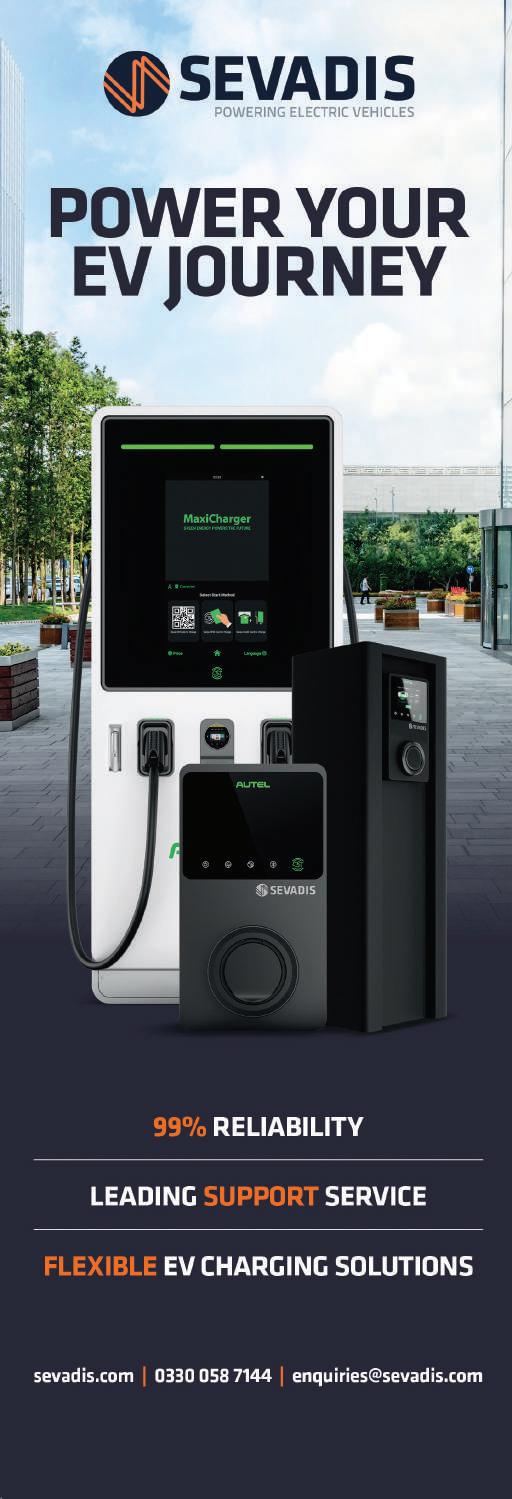
The longer that Northgate offers its Drive to Zero proposition to companies as they transition their LCV fleets from diesel to electric, the more we are aware that there is no ‘one size fits all’ solution.
Northgate starts by assessing a company fleet and its suitability for electrification, which includes everything from EV running costs versus ICE, driver access to charging at home and on the move, to matching up the right vehicle to the right driver and journeys.
Using data to initiate the transition
With the help of driver and/or telematics data, we can build a complete understanding of vehicles, their movements, distances travelled and journey times, which allows it to identify which vehicles can be immediately switched to electric power. And more importantly which vehicles should be delayed until higher range electric LCVs are more readily available.
Currently our rule of thumb is not to encourage vehicles that cover more than 160 miles a day to go electric, but that doesn’t stop companies from reducing LCV emissions even if they continue to run diesel LCVs.
Greater vehicle utilisation and improved driver behaviour behind the wheel will not only reduce carbon emissions but also fuel costs.
“By measuring and then improving the utilisation of vehicles and drivers, companies will immediately reduce their carbon footprint even before they move to electric vehicles,” explained Neil McCrossan, Northgate’s Managing Director. “When a company is ready to switch to EVs these insights and data will be vital when helping decide which drivers and electric LCVs to put on individual delivery routes.”
Installing telematics is the number one way to help fleets track their vehicle journeys and utilisation, plus record individual driving styles to enable them to influence and improve driver behaviour. A customer saved £53,000 in the first year of installing Northgate’s telematics to its vehicles by avoiding congestion charge and ULEZ charges.
Better route management also immediately reduces mileage, fuel costs and

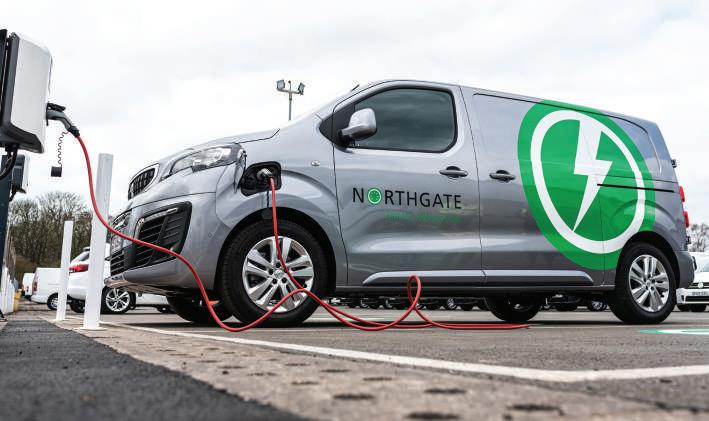
“Northgate is the only vehicle rental provider which combines van rental and charger provision as a single bundle, offering EV hire, and home charger installation and rental in a single monthly fee”
therefore emissions. Right-sizing vehicles is another conversation our team has with operators particularly around downsizing based on the capacity and weight of loads being carried which can have an immediate impact on carbon emissions.
All vehicle and driver data will help influence the electric LCVs that best match individual operator journeys when they start their EV onboarding process.
“None of this initial work to reduce carbon levels will go to waste prior to EVs being added to a fleet,” said McCrossan.
The provision of suitable charging infrastructure is a crucial step to ensuring a smooth transition for any business, which Northgate manages in association with sister company ChargedEV.
ChargedEV can help companies understand their workplace charging, home charging or even public charging requirements to ensure the best possible solution can be found. It can also help and support with major infrastructure planning which involves working with local energy suppliers to install and futureproof a company’s charging needs.
Van rental and charger in a single bundle
Northgate is the only vehicle rental

provider which combines van rental and charger provision as a single bundle, offering EV hire, and home charger installation and rental in a single monthly fee.
As part of our Drive to Zero programme we are hosting 12 EV roadshows during 2024 which give companies a chance to drive a range of electric vehicles and talk to experts on all the different aspects of electrification.
At the recent Reading EV roadshow, 48% of fleets admitted that carbon reduction was their main motivation for reducing emissions with 22% saying they were motivated by the potential cost savings of moving from diesel to electric. A further 24% said their electrification journey was all about fulfilling customer requirements.
Despite this positive approach to carbon reduction, fleets remain concerned at the cost and implementation of the transition process. Just over one third (36.3%) said cost was a major concern while a further third (33.3%) said implementing the change was set to be their biggest challenge.
Meanwhile, 15.1% of fleets said they were concerned at both charging and vehicle choice in equal measure when looking to replace diesel LCVs directly with equivalent EVs.
All these comments confirm that every company’s needs are different and their journey from diesel to electric will navigate a different route.
Northgate’s Drive to Zero has been set up to help that process using its vast expertise of working with thousands of companies and running a fleet of 50,000 LCVs.

The traditional company car scheme, once a coveted perk, is facing a major crossroads. Environmental concerns, changing work patterns and, most importantly, new tax incentives are forcing businesses to rethink their approach to employee mobility.
Thanks to advantageous tax incentives, salary sacrifice schemes are emerging as the pre-eminent solution that delivers benefits for both employees and businesses, paving the way for a more sustainable and employee-centric future.
Post-Covid, working practices have changed, and we can identify three key pillars: prioritisation of sustainability, the need to build resilience, and employee demands for increased flexibility. The public sector can lead the way on sustainability, but innovation from the private sector will drive the latter two priorities.
One avenue to make businesses more sustainable where the public and private sector have aligned is electrification of business fleets, in large part due to low Benefit in Kind (BiK) on electric vehicles.
Battery electric vehicles and plug in hybrids have enjoyed enviably low BiK rates since changes in tax policy in 2020. While rates for electric vehicles and plug-in hybrids will rise after 2024, they remain vastly lower than their petrol and diesel counterparts. The incentives have encouraged electrification, but the private sector has lagged in adding in resilience and flexibility. Plummeting EV values make the vehicles themselves a volatile asset, while the traditional car lease ties the business into a fixed contract which can become a lodestone if an employee changes their career or work-life balance.
Fortunately mycardirect is innovating by offering a salary sacrifice scheme with in-built flexibility.
Gone are the days of rigid company car schemes. Mycardirect’s salary sacrifice scheme prioritises employee flexibility and choice. With a wide selection of EVs and PHEVs available, employees can choose the perfect car that fits their lifestyle, budget, and range requirements. Employees are provided with a car that caters to their needs.
Furthermore, mycardirect’s salary sacrifice scheme allows employees and businesses to take advantage of our flexible subscription terms. Unlike traditional leasing, you retain the freedom to adjust your subscriptions as your needs change. You can cancel, extend, or swap your car for a different model from month to month, offering unparalleled flexibility and adaptability. As cars can be returned with short notice, the company won’t find itself with an unused asset if an

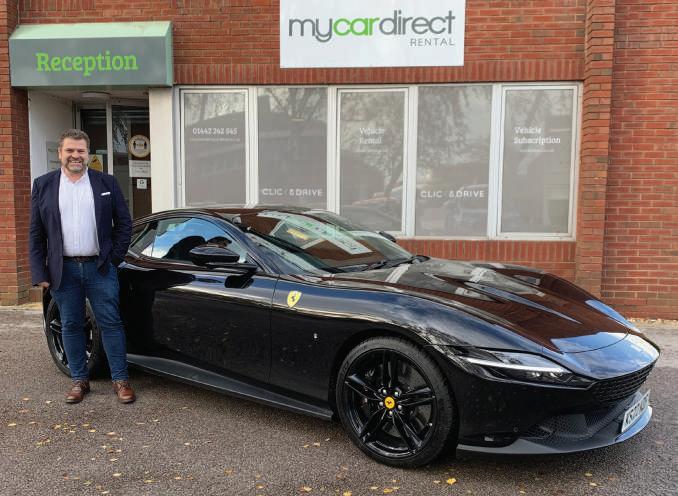
employee leaves, and employees can change their vehicle if they need an EV with a greater range, for example.
For employees, salary sacrifice offers a win-win proposition. By sacrificing a portion of their pre-tax salary, they gain access to new EVs and PHEVs, significantly reducing their tax liability and monthly payments. These cars, previously considered premium options, are now more financially accessible to a wider range of employees.
The advantages of salary sacrifice extend far beyond employee benefits. Businesses gain significant operational and financial advantages. Mycardirect’s salary sacrifice
“Subscription salary sacrifice has the potential to revolutionise employee mobility, pave the way for a greener future, and redefine the way we think about company benefits...”
scheme has no set up fees or ongoing running costs; we even take care of the payroll considerations. By partnering with mycardirect, companies outsource the fleet management, eliminating administrative tasks like vehicle sourcing, maintenance, insurance, and paperwork. This frees up valuable internal resources that can be directed towards core business functions.
Furthermore, salary sacrifice schemes present a powerful tool for attracting and retaining top talent. In a competitive job market, offering unique and future-oriented

benefits like access to EVs and PHEVs can be a significant differentiator. Millennials and Gen Z, in particular, place a high value on environmental responsibility and financial flexibility, making salary sacrifice schemes highly attractive.
Naturally salary sacrifice isn’t a magic bullet, and won’t be a perfect fit for all. If your business isn’t ready to go electric, we can also offer car and van subscriptions for business, and you’ll retain all the flexibility to swap, return and extend from month to month. A monthly car subscription allows you to flex your fleet, and offers the perfect solution for niche employee mobility needs. If you have employees on probation, need to bring in temporary staff or contractors for a project, car subscription is the perfect solution.
We can also offer nationwide vehicle rental through our sister company ONWRD, and traditional car leasing through BestCarFinder
As we move towards a more sustainable future, embracing innovation and prioritising resilience and flexibility across all aspects of business will determine who sinks and who swims. Salary sacrifice schemes, with their focus on employee choice, cost-effectiveness and environmental responsibility, represent a shift in the right direction for company cars, but the added flexibility of mycardirect’s subscription salary sacrifice scheme is the gamechanger the industry has been waiting for. By empowering both employees and businesses, subscription salary sacrifice has the potential to revolutionise employee mobility, pave the way for a greener future, and redefine the way we think about company benefits.

New Range Rover Evoque has a charismatic, sophisticated character, with its reductive design now enhanced with the latest technologies and luxurious material choices for modern luxury clients.
Outside, the exterior presence is enhanced by a new grille and super-slim Pixel LED headlights with signature DRL. New exterior accents and colours also complement the characteristic floating roof, unbroken waistline and the flush deployable door handles.
Inside, Range Rover’s reductive design philosophy is amplified with a new 11.4-inch curved glass touchscreen, seemingly floating within the driver’s eyeline for improved visibility, while liberating space for interior stowage and Wireless Device Charging.
The latest technologies and material innovations also promote wellbeing in the refreshed cabin, provided by one of the most sophisticated interior air quality technologies in its class. Tactile material options include non-leather UltrafabricsTM and KvadratTM textile seats to provide a new dimension of modern luxury.
Clients have a choice of Evoque S, Dynamic SE, Dynamic HSE and Autobiography models.
Electrified performance
Range Rover Evoque offers a range of plug-in electric hybrid and mild hybrid electric power, delivering fuel-efficiencies and performance. This includes the advanced P300e plug-in electric hybrid, available alongside a range of Ingenium petrol and diesel engines which all feature the latest Mild Hybrid Electric Vehicle (MHEV) technology to boost efficiency and responses.
The P300e electric hybrid offers clients the best of all worlds, enabling Range Rover Evoque drivers to complete their average daily journeys with zero tailpipe emissions, thanks to an electric-only range of up to 62km (39 miles) from its 14.9kWh battery. The electric hybrid powertrain combines an efficient three-cylinder Ingenium petrol engine with an 80kW electric motor, providing a total power output of 309PS, 0-100km/h in 6.4 seconds (0-60mph in 6.1 seconds).
Updated battery chemistry offers an improved real-world driving experience, with an expected real-world electric range of up to 48km (30 miles).
On longer journeys, this means a total real-world range of up to 651km (404 miles) with CO2 emissions from 31g/km.4
Rapid DC charging is standard on the

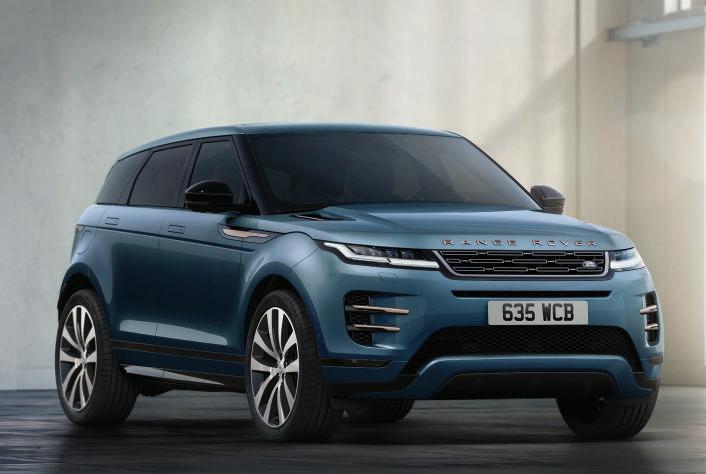
Evoque P300e, ensuring swift charges away from home in as little as 30 minutes, meaning the next electric-only drive is only a short charge away. Using a 7kW home charger, 0-100% charge can be completed in around two hours.
Advanced mild-hybrid electric (MHEV) petrols and diesels complete the line-up. The technology enhances efficiency and responsiveness by using a Belt integrated Starter Generator (BiSG) to harvest energy that is normally lost under braking and deceleration.
It is stored in a 48-volt lithium-ion battery beneath the loadspace and is redeployed when accelerating, delivering a more refined operation of the fuel-saving start-stop system.
Trademark Range Rover engagement and composure on all terrains is provided by advanced chassis technologies.
Adaptive Dynamics – where fitted –ensures suspension stiffness is optimised for the driving conditions, improving ride comfort and handling.
There’s even a specific calibration for off-road driving, while altering driving parameters via the Configurable Dynamics system delivers exceptional performance and agility on-road.
Supreme all-terrain breadth of capability is guaranteed by the intelligent torque on-demand all-wheel drive (AWD) system, providing the optimum torque distribution to suit the conditions, whether driving

dynamically on the road or pulling away from a standstill on slippery surfaces.
Terrain Response 2® is accessible through Pivi Pro2 and allows the driver to adjust vehicle settings to suit the driving environment, with a choice of Eco, Comfort, Grass-Gravel-Snow, Mud-Ruts, Sand, Dynamic and Automatic mode. Each alters the calibration of the engine, transmission, all-wheel drive system, suspension and stability control systems for optimum traction and composure.
Innovative material options are available in addition to traditional leathers, while sophisticated new detailing – including Moonlight Chrome found on the steering wheel, centre console trim and air vents –provides a new air of refinement.
Moonlight Chrome complements new trim finishers, which include Technical Light Anodised or Dark Anodised Aluminium (depending on model), with Shadow Grey Ash Veneer providing an elegant finish on Range Rover Evoque Autobiography.
The Range Rover Evoque’s colour palette now features Arroios Grey, Tribeca Blue and Corinthian Bronze, while contrast roof options enable clients to express their individuality, with Narvik Black and Corinthian Bronze to choose from. Its exterior character is enhanced further with a total of eight alloy wheel designs up to 21 inches in size and five new finishes, with diamond-turned offered on the Range Rover Evoque Autobiography and Dynamic HSE.
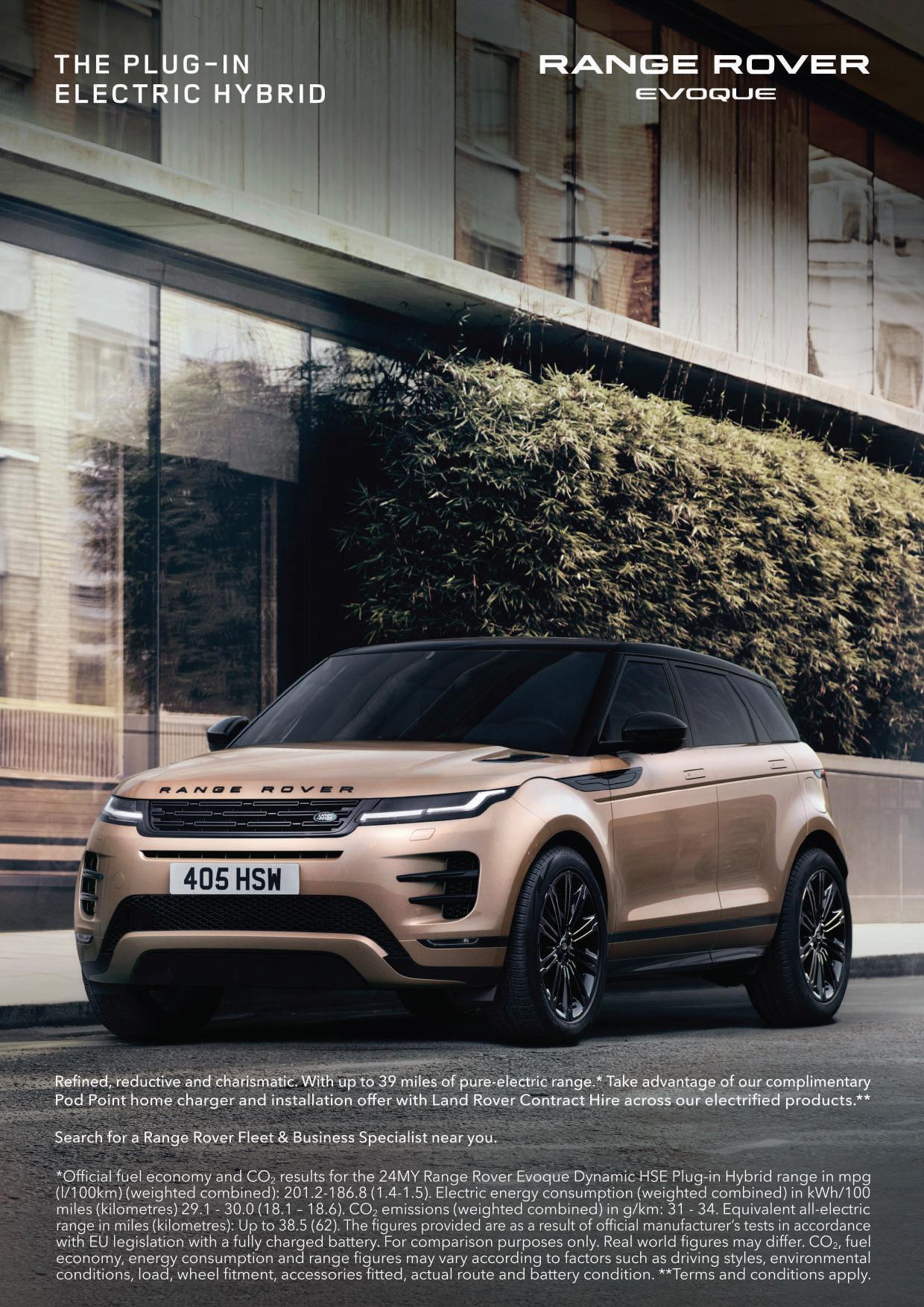
Our Small Car of the Year, the Mazda MX-30 R-EV, is definitely a plug-in with a difference. Andrew Walker explains why
The Mazda MX-30 e-Skyactiv R-EV, to give it its full name, features a 17.8kWh battery and 830cc rotary engine generator. This acts as a generator to enable longer distance drives without range or charging anxiety. With no mechanical connection between the engine and the wheels, the rotary unit acts as a generator so it’s always driven by the electric motor. Electric range is 53 miles with a 50-litre fuel tank giving it a flexible 400 mile total range.
Model choice, trims and price
The MX-30 R-EV comes in three grades; Prime-Line, Exclusive-Line and Makoto. Entry-level Prime-Line models start from £31,250 and come fitted with 18” alloys, LED headlamps, all-round parking sensors, a reversing camera, head-up display, 8.8” infotainment system, separate 7” touchscreen for the climate controls, cruise control, lane departure warning with of course, Apple CarPlay and Android Auto smartphone connectivity. Exclusive-Line costs from £33,150, while the range-topping Makoto costs £36,000 but adds an opening sunroof, heated steering wheel and a 12-speaker Bose sound system.
Charging
It is compatibility with both AC charging and rapid DC charging with 3-phase AC charging takes around 50 minutes. DC rapid charging can be completed in around 25 minutes. The ability to use rapid chargers is uncommon among conventional plug-in hybrid rivals which is good news for customers. Using a 36kW charger the battery can be charged from 20 per cent to 80 per cent in 25 minutes; with a threephase 11kW AC charger the battery can be refilled in approximately 50 minutes, while a single-phase home 7.2kW charger will take around 1 hour 30 minutes.
The R-EV’s CO2 is just 21g/km. Top speed is 93mph; 0-60mph time of 9.1 seconds.
There are three drive modes: Normal, EV and Charge. Normal delivers electric drive as long as there’s enough battery charge. EV mode stays in electric drive until the battery is completely drained. Charge mode can be used to retain EV range, with the option of setting the amount to reserve in increments of 10 per cent. The engine will go into Normal mode if and when more power is required or the electric range has run out.
Inside
Cleverly designed and finished. The use of



MX-30 R-EV is plug-in with a different look


environmentally-friendly materials, such as cork, vegan leather and recycled plastic bottles is tastefully done. As with the pure electric MX-30, the MX-30 R-EV features steering wheel paddles that adjust the level of regenerative braking.
A particular favourite of ours is the separate 7” climate control touchscreen, which allows the driver to adjust the temperature without having to scroll through numerous menus.
Storage space is good, with two large door pockets, a sizeable glove box, two cup holders and an armrest with underneath storage. There’s also a useful storage area underneath the floating centre binnacle, where you’ll find two USB inputs and a single 12v socket.
It doesn’t have proper rear doors; you get freestyle suicide doors. While these look fantastic and will work well with younger children, even with the clever electric front seat mover an adult will struggle to get in and out with any dignity, and anyone over five feet eight will find it a very tight squeeze.
Despite the engine being just 830cc in size, from start you can barely hear it. It only produces 74bhp at 5,500 revs and you’d expect some whining. However, even driving
through Snowdonia over some challenging climbs you hear only a faint hum.
Quick off the mark it maybe, but it’s no speedster and you’d be hard-pressed to call it exciting. For a small car it feels quite grown up. There’s little body roll and it runs really well over both good and poor road services. It feels well poised and handled the tight turns and corners we encountered with aplomb.
The cabin is very comfortable and the build quality and finish is exceptional in this class.
In the city and on the motorway you’ll quickly realise that it fits in anywhere.
As far as fuel economy goes, Mazda claims a WLTP combined of 282.5mpg. As with all plug-ins, take that with a pinch of salt. We managed was a high of 136mpg but in rural Wales and on the M53 when utilising the rotary engine, it was closer to 45mpg.
Pros
Amazing build quality for a £30,000 car. It’s beautifully designed. On trend tech. Low BIK for company car drivers.
Cons
The rear doors limit its appeal.
Plug-in option of 50+ pure electric range makes it a brilliant compromise between ICE and full electric. Build quality excellent. Only real negative are the rear suicide doors. However, it is only small car plug-in hybrid that comes with DC charging and a 400-mile combined driving range.
CC&V RATING: N N N N

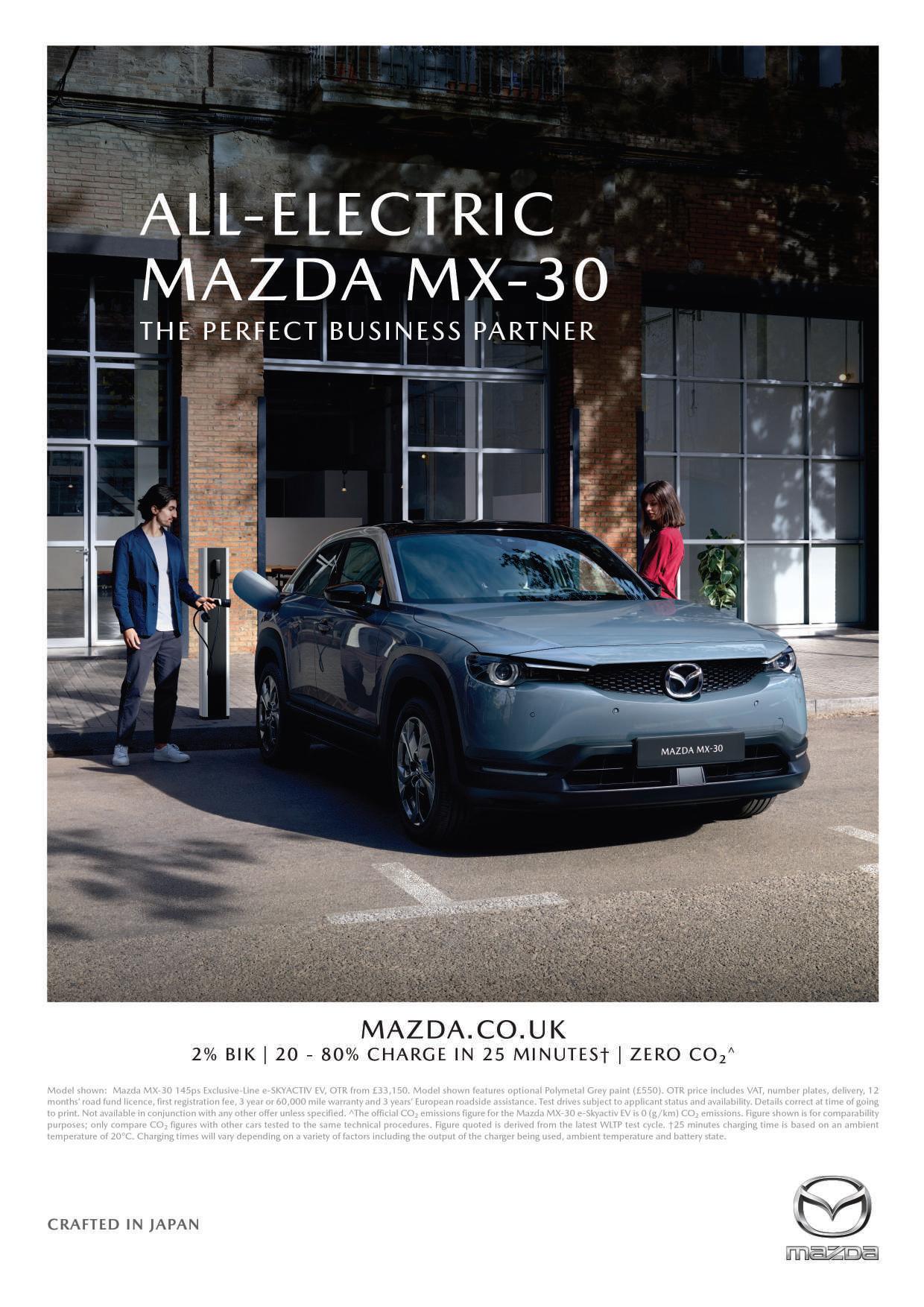
Andrew Walker
In order to appeal to company car drivers, manufacturers know they need to offer them what they want, and what they want right now is a plug-in hybrid or EV. To its credit, JLR has cottoned on to this and along with the electric I PACE, has electrified the F-Pace and E Pace models with plug-in technology. And at the same time, they’ve upgraded the F-Pace interior and infotainment set-up, making a car we liked to drive, even better.
What is it?
The F-Pace P400e is a large 4WD SUV that comes with plug-in hybrid technology, aimed specifically at the company car sector.
Engine choice
There is just one available and shared with the Defender plug-in, but it’s very good. So factor in a 4-cylinder, 2-litre petrol engine with an electric motor powered by a battery producing 404 hp and 640 Nm of torque, which is good for a 0-60mph time of just 5.0 seconds and a top speed of 149 mph. The 105kW (141bhp) electric motor mounted between the 296bhp four-cylinder Ingenium motor and the eight-speed ZF auto transmission is what adds the extra oomph and, of course, give you that all important electric range.
Battery and range
As a company car publication, battery range is probably the second most important thing you need to know after BIK - from 11%, since you asked. Fitted with a 17.1kWh battery located beneath the boot floor, the P400e is good for 33 miles of pure electric range, which in our experience of a drive in poor weather, was actually good for around 25 miles. Lower, but s=till pretty good.
On a 7kW home charger like our own Rolec, (https://www.rolecserv.com/ev-charging) the P400e will take 2.5 hours to charge to full. You can rapid charge using a DC unit where available, up to 32kW, cutting the time to top up to 80%, to just 30 minutes.
Our advice as ever is get on a special electricity tariff for EVs, plug-in at home at night when rates are 7.5p a kWh and in the P400e’s case, you’ll charge it up for just 25p overnight to get approximately 25 miles of pure electric driving.
The quality of the cabin is excellent. So you get the latest version of JLR’s Pivi Pro infotainment system, incredible build quality and all the latest safety features you’d expect from a luxury SUV. It also features
some lovely finishes, even lower down and on the doors, where many other premium brands cut corners. There’s a pop-up driving mode selector, which includes several off-road settings.
The gear stick sits plum in the centre of the front seats with the start button and climate controls just above. You get a tidy analogue display in front of the driver and a Heads Up display as well.
New additions which improve the cabin experience include road noise cancellation and cabin air ionisation.
The new Pivi Pro is a massive improvement over what came before. It’s all worked through an 11.4” touchscreen and will connect two phones at once via Bluetooth. The new screen menus are easy to understand, with clear graphics and quick response time. Connecting your smart phone to AppleCar Play or Android Auto is simple and switching between the DAB radio, podcasts and music was smooth as well.
Perhaps our only criticism is that the twin USBs are located within the under arm rest space, making cable attaching a bit of a chore.
Continued on page 22
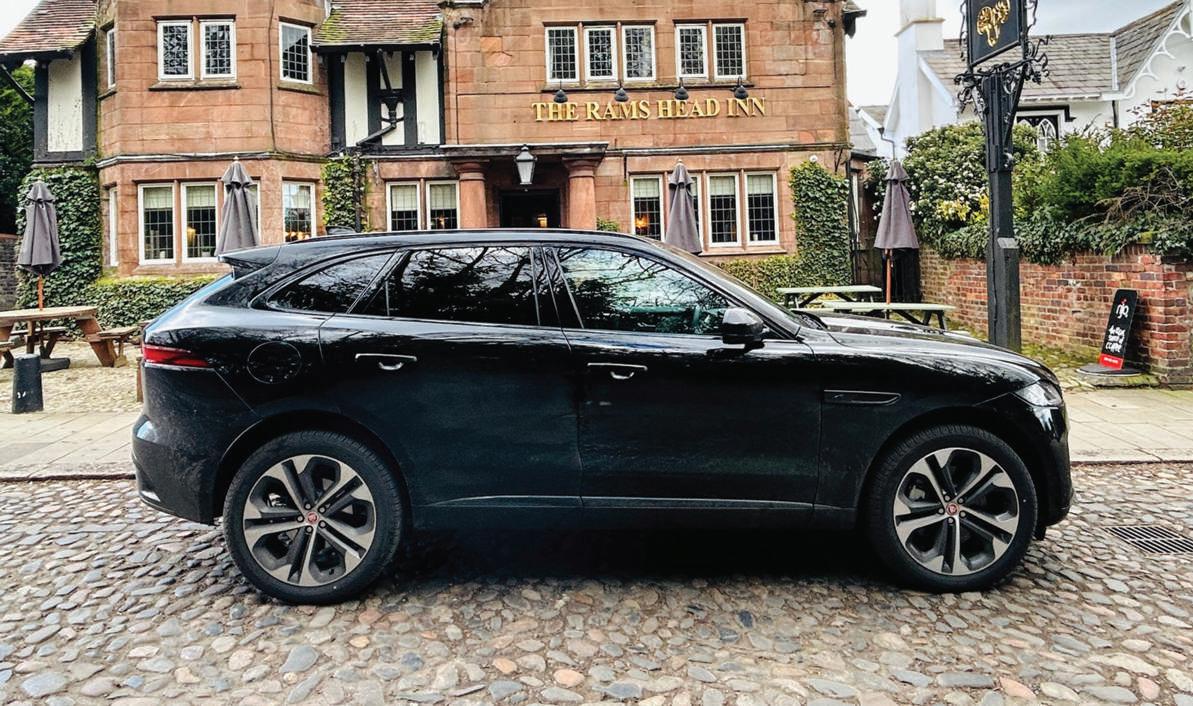

Continued from page 20
Inside there’s a good use of space and plenty of storage: glove box, door pockets, arm rest cubby, twin cup holders and a floating space between the front seats. In the rear there are separate heating vents, seat back nets and a 12v socket, but no USB connectors. Front head and legroom are decent and two adults have plenty of space in the back as well. The boot suffers from having the battery squeezed in under it, so you only get 522 litres rather than 650 in the ICE F-Pace, otherwise we can’t fault it.
A family trip up north meant 350 miles of motorway driving. But for the few days prior, it was just local driving, so we were able to utilise the EV range making five-mile round trips daily under electric power.
The F-Pace offers a SAVE function as well as EV or HYBRID, allowing you to keep your electric range for urban driving. You just have to remember to set it each time you re-start the car.
Over 25mph the car moves into Hybrid mode which allows it to choose the best way to power the car, electric, petrol or both. It works seamlessly and the engine noise between gear changes is barely noticeable thanks to the new cabin soundproofing.
On the motorway, the P400e comes with a suite of safety features including ADAS, so you simply need to build up to your chosen speed using the cruise control buttons which are located on the right-hand side of the steering wheel. In November weather, with strong wind and rain, the F-Pace was quiet

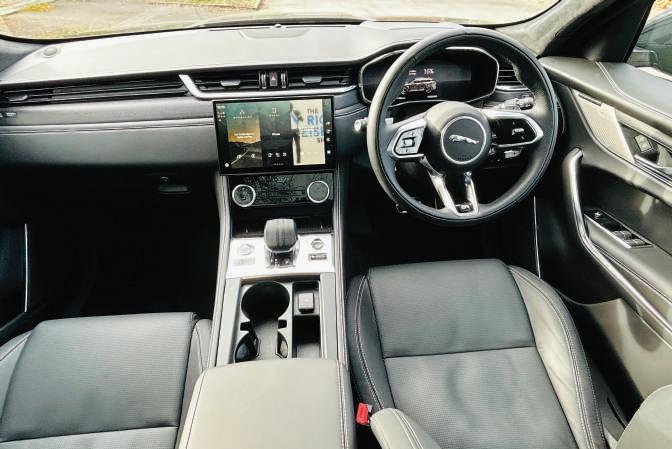
and comfortable enough for four passengers to listen to their own devices without excessive noise.
Move out of Eco mode into Dynamic and you’ll notice the car defaults to a firmer ride and increases the torque, which is especially useful for swift overtaking.
On some local roads you’d expect the battery weight to butt in, but it’s really not that noticeable and the car handles well, with nicely balanced steering. Overall the F-Pace is both comfortable and refined, with some good old-fashioned power on offer if you need it.
Real world range
Seven days, over 400 miles, most at motorway speeds with four adults on board




saw us return a decent 38.8 mpg. Using just the battery this was as high as 116mpg before we headed out at motorway speeds, but for a large 4WD SUV we think 40-oddmpg is very good.
Pros
Great to drive, exceedingly comfortable and tremendously well equipped.
Company car drivers can smile too, with big BIK savings over the F-Pace diesel or petrol versions and a pure electric range of 25-33 miles.
The addition of the latest JLR Piv Pro and improvements in the cabin such as Apple CarPlay connectivity and a refreshed layout also score highly.
Cons
Expensive. The load space is compromised compared to the ICE F-Pace. Lack of rear USBs. That’s about it.
It might not be cheap but the P400e’s company car tax saving credentials are the real winner here. The cabin is comfortable and spacious and much improved over the original F-Pace. Only the smaller boot space is a compromise. If you’re looking for a large SUV that’s great to drive, will return close to 40mpg, undercuts similar offerings from Germany on price, it’s well worth considering.
CC&V RATING: N N N N

The Toyota Proace City Electric offers van operators a small electric van with a cargo area of up to 3.3 cubic metres and a useful battery electric range of 161 miles. Like the larger Proace Electric, the City Electric is built in conjunction with other small electric vans in the Stellantis group, from Citroen, Peugeot and Vauxhall, and gives Toyota another string to its bow in the electric van market.
Andrew Walker drove one recently and here’s what he thought.
The Proace City Electric comes in either SWB or LWB panel van options. The shorter wheelbase models have an 800kg payload, while long-wheelbase models have a 750kg payload, but come with a larger loading area. Both versions feature the same 50kWh battery, which offers a WLTP range of 171 miles.
In SWB or LWB versions, the City is offered only in Icon. Fear not, however, as Icon offers the van driver plenty of standard equipment, including two sliding side doors, a reversing camera, smartphone integration for Apple CarPlay and Android Auto, front parking sensors, a reversing camera, DAB, two USBs, air-con and cruise control.
The 50kWh battery uses a 100kW electric motor, putting out the equivalent of 136bhp. This is good enough for a top speed of 80 mph, but it’s the instant torque that’s most impressive, making forward progress smooth as well as silent.
Fast charging is included as standard. This means that the City Electric can top up its battery from 0-80% using a 100kW rapid charger, in just 30 minutes. This, of course, is quite expensive so most of your charging will take place at home, where using a 7kW charger, like our own Rolec Smart Charger, charging the 50kWh battery from 0-100%, will take 7.5 hours.
Toyota also offers the option to upgrade from 7kW Type 2 charging capability to 11kW, so a home charge can take as little as 4.5 hours.
Make sure you switch your electric supplier and tariff to one that offers cheaper overnight electricity prices, such as Octopus Go. For example, using the EV Energy App, who partner Rolec, you can set your charger


“The 50kWh battery puts out the equivalent of 136bhp and a top speed of 80 mph, but it’s the instant torque that’s most impressive, making forward progress smooth as well as silent...”
to only charge at off-peak times and can even set a price per kWh limit.
Interior and exterior
We were testing the Proace City Electric Icon L1 50kW model. The electric City looks just like the diesel model, with just a slight nod to its electric roots, namely ELECTRIC logos on the rear door and front nearside.
The interior has a car-like feel to it, with the dashboard dominated by the colour touchscreen. It’s also finished in nicely textured plastics, with the grey seat fabric looking and feeling hard wearing.
I had a good look around my test van before I took it out and it featured the Toyota Smart Cargo bulkhead with a hatch, allowing

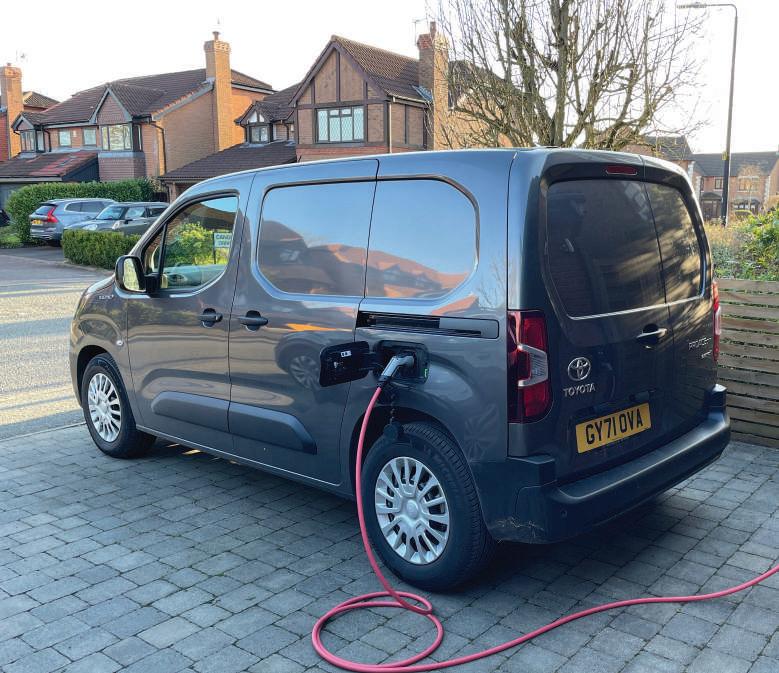
a longer load length to fit into the cargo area and into the front rear left passenger footwell. After some recent storms I needed to repair a fence so required two 3m lengths of wood. I was able to slide these over the front passenger seat into the perfectly placed dashboard gap, managing to just close the rear doors. Perfect!
There’s also under passenger seat storage, large enough to store a small bag, two decent sized door pockets, storage between the front seats, twin drinks holders on the dash top and space lower down for odds and ends. The only negative is that the centre-front seat doesn’t offer much legroom.
However, to compensate for this the twin sliding side doors and 180° opening rear doors make getting in and out of the van easy.
What’s really appealing about City Electric is that it drives like a small electric family car. Steering is light and the auto gear box located just to the left of the driver is easy to operate. Here you can select from Park, Reverse, Neutral or Drive with another setting ‘B’ that adds two levels of regenerative braking to the equation.
Continued on page 24



Continued from page 23
On the road
There are three drive modes: Eco, which slows everything down and turns off the heating; Normal, in which we drove all week; and Power, useful if your van is heavily laden.
In Power mode you get the van’s full 134bhp and the most fun, with quick acceleration from a standing start. The downside is that it reduces the range considerably. The 108bhp you get in Normal mode is the level we used, primarily because it was cold. This gives you a good amount of throttle response. Selecting ‘B’ mode in the gear selector puts some energy back into the battery when coasting. It’s not really noticeable and certainly doesn’t offer anything strong enough to allow for single-pedal driving.
On the motorway, the City Electric drives nicely. The cabin is quiet thanks in part to the full steel bulkhead and the seats offer a firm and supportive ride. The driver’s view of the road is good, and switches and buttons fall easily to hand.
The Icon is fitted as standard with cruise control, which allows you to select your motorway speed and in turn aids battery range. The City Electric also does a good job of masking the battery weight under the floor plan, making it a fun small van to drive, especially in town.
Range
Once I had charged the City Electric fully at home on my Rolec charger, https://www. rolecserv.com/home-charging, the total battery range showing was 161 miles in Eco and 151 miles in Normal. Some local journeys saw us achieve the holy grail of a 1:1 ratio of distance travelled to range used. As with all EVs though, the range isn’t as great when you drive over 65 mph and in low


temperatures. We took a 50-mile motorway spin in February, with outside temperatures of just 3 degrees celsius. Travelling at a constant 65mph, we used up 68 miles of range.
Pros
Excellent payload, great to drive, topnotch cabin, on-trend tech and if driven carefully, expect a range of 130 miles. As with the firm’s passenger cars, the Proace City Electric is covered by Toyota’s 10-year service warranty, which should bring added peace of mind to business users tempted to make the switch to electric. It’s worth noting that the Stellantis competitors are not this generous with their warranties.
Cons
The Proace City Electric Icon comes
supplied with a higher spec than the Stellantis versions, which makes it a little more expensive. Like all EVs, be aware that very cold weather and a heavy right foot will affect your range.
Electric vans struggle for range if they are being driven all over the country. However, if your van use is local, even regional, then the Proace City Electric could be a solution. An electric van is plainly cleaner, you don’t need to pay VED and EVs are currently congestion charge exempt. And, we haven’t even mentioned the fuel savings... or the great warranty, competitive payload and latest tech and safety.
CC&V RATING: N N N N


BMW’s electric range is gaining pace, with the latest model to be electrified the iX2. Where once any company car driver looking at electric had a fairly limited choice, the iX2 is another good-looking car to enter the fray, as BMW tries to tempt customers away from the Polestar 2, Tesla Model Y and Audi Q4. Andrew Walker reports...
Tell me more
The iX2 is certainly striking and if you value looks over practicality, it knocks spots off the iX1. It’s a hybrid coupé-SUV with plenty of room on board for four and a beautifully finished cabin.
Model choice and battery range
The iX2 eDrive20 is the entry level model. It features a single front-mounted motor producing 201bhp with 250Nm of torque, so it won’t hang around. Fitted with a 64.8kWh battery, BMW claims a range of up to 283 miles. We joined other media testers at the iX2 launch event in the Cotswolds where we had a chance to test the more powerful iX2 xDrive30, which comes with dual motors, one on each axle, more power – 309bhp –and a massive 494Nms of torque.
It too comes with the 64.8kWh battery but being heavier, range is reduced to a maximum of 267 miles.
Charging
The BMW offers rapid charging at up to 130kW, so someway behind a number of competitors. Still, a 10-80% charge will take approximately 30 minutes on a public fast charger, while at home using a 7.4kW wall box, expect a charging time of between 8 and 9 hours from 0-100%. As ever try to keep your battery above 50%, plug-in at night when electricity is cheaper, and 30kWh will cost you just £2.25.
BMW also pointed out that the iX2 features some clever software optimisation when charging, so 10 minutes charging at the maximum rate will add 46 miles; helpful if you’re in a hurry.
Interior and features
Both versions are finished in M Sport trim. Standard equipment is generous and includes

iX2dDriver30
0-62mph: 5.4 seconds
Top speed: 155mph
Power: 309bhp
Battery: 64.8kWh
Range: 267 miles

19” alloys, Alcantara upholstery, heated front sports seats, a power tailgate, air-con, SatNav – which is one of the better manufacturer’s ones – Android Auto, Apple CarPlay, Bluetooth, Wi-Fi, a 10.25” digital instrument panel, automatic lights and wipers, cruise control, parking assist and self regulating M Adaptive Suspension.
The colour combo inside our test car was black and cream with a diamond texture on the black dashboard top and elements of chrome finish. The overall build quality is
excellent with some nice soft touch finishes on the dash top, dash front, armrest and doors. Only the door pocket plastic felt underwhelming, but otherwise it looks and feels like a 50k car.
Extras
BMW customers will be familiar with its add-on packs and our test car had extras fitted including a Technology Plus Pack costing £2,890. This included acoustic glass, BMW Live Cockpit, head-up display, Parking Assist Plus, High Beam Assist, adaptive LED headlights, iconic glow kidney grille, Comfort Access, folding wing mirrors with autodimming and storage for wireless charging. M Sport package Pro was also included: this adds M Sport brakes with red callipers, BMW individual Shadow Line lights, M Sport seat belts and spoiler; all yours for an additional £1,710.
Infotainment
Fitted with BMW’s OS9 infotainment

system, the 10.7” central touchscreen makes almost everything tick. BMW has cleverly included some permanent short-cut icons for the climate and heated seats. The adjustment via the screen therefore is actually quite logical and easy enough to grasp. The screen itself is super-clear and response time is excellent. Most functions can be accessed by scrolling left and right on the screen itself, with a ‘home’ button giving you a comprehensive list of everything on offer. Selecting the functions within this menu requires a bit of a search but after a few tries you’ll know where to go.
The cabin itself is roomy, at least up front. You get a good-sized glove box, front door pockets, dual centre cup holders, an armrest that opens with storage underneath and, our favourite touch, a space-saving vertical wireless charging pad with built-in clip to lock your phone in place.
Rear passengers have good legroom but the sloping roof means taller passengers may be rubbing their head on the black roofline, which also makes the cabin feel a little gloomy.
The centre rear seat isn’t very big, making this more of a day-to-day four-seater. Good news is that there are twin USB-C ports feature between the front seats.
Boot
Boot space is pretty good , so 525 litres are available with the rear seats in place. This increases to 1,400 litres with them folded. A useful touch is that the boot floor lifts up to reveal a large enough space to tidy away two charging cables.
“BMW has aimed to make its electric cars as driveable as possible and, in our opinion, is doing a better job currently than Audi or Mercedes ... compared to other electrics, the iX2 performs admirably”
The latest BMW operating system features ‘My Modes’: Personal, Expressive, Sport and Efficient. These have been designed to not only alter the way the iX2 drives but also to change the overall ambience of the interior, with different cabin colours for each driver setting.
The twin-motor system also offers three regeneration settings. You can utilise these by simply pulling the gear switch back into D, and once more for B. It features High, Low and Medium settings. If you don’t want to choose one yourself there’s an Adaptive mode that will handle it for you. It responds to upcoming junctions and changes in speed limit as well as to vehicles that are in front of you so is very intuitive. Even in the highest setting it’s not one-pedal driving though.
On the road
BMW has aimed to make its electric cars as driveable as possible and in our opinion, is doing a better job currently than Audi or Mercedes. The iX2 features adaptive dampers as standard with the suspension
settings mated to the driving modes which also alter the car’s steering weight and stability control. In the iX2’s case it’s 2.1 tonne kerb weight and crossover shape mean that it’s not as sharp or as much fun to drive as i4 and i5 saloons . Nonetheless, compared to other comparable electric cars, the iX2 performs admirably.
The ride is firm but compliant, as the suspension, particularly in Efficient driving mode, isn’t too harsh. Sport mode stiffens the steering and the suspension feels firmer, especially over poor road surfaces. In a straight line Sport is a lot of fun but Expressive or Efficient were better options for driving day to day.
Cornering is typical of a heavy EV. Not a lot of feel, but this is counter balanced by very able road holding. Our test car’s 20” wheels were pretty good at blanking out road noise, although the smaller 19” wheels should be even quieter.
Our flat test route allowed for some 60mph driving and where able, we selected the adaptive cruise control so we could relax and let the car do the work The massive torque offers instant punch in Sport mode, so some broad smiles can be had; this would be useful when joining a motorway or overtaking.
Overall the horse power on offer is well hidden in what is in effect, a family-friendly offering that looks sportier than perhaps it is.
The cabin itself is comfortable and a pleasant place to spend time in. Even though the BMW SatNav is one of the better versions around, we prefer to utilise Apple Maps or Waze. Connecting wirelessly to Apple CarPlay was a doddle.
Continued on page 28
Vertu Motors PLC purchased four BMW & MINI centres in December 2021, in Sunderland, Teesside, Durham and York, and ever since corporate growth and business development has been at the forefront of its ever-improving strategy.
Bolstered by an acquisition of a further five BMW & MINI centres in the south west in 2023 – in Exeter, Bridgwater, Yeovil, Barnstaple and Dorchester – Vertu has strengthened its portfolio of award-winning BMW and MINI centres. Offering a truly national operation, it can now fulfil all orders and provide a local showroom collection or enclosed delivery option to all of its corporate and business customers.
The Vertu Corporate department specialises in all areas of the corporate marketplace from supplying into public sector, national end user, local owner-operated business and also into the numerous FN50 leasing companies. It is this all-round expertise and understanding that is enabling Vertu and its BMW and MINI division to achieve continued growth.
Vertu sees local business as fantastic area for growth and is proactively targeting the SME and B2B sectors specifically within a drive time of 20 minutes from its centres. All of its Local Business Development specialists have recently undergone role and brand specific training within the BMW Group Academy and are able to offer accurate, impartial advice on the perfect BMW or MINI for your business, as well as being able to offer the most tax efficient and costeffective funding methods.
As part of the BMW and MINI Corporate network, Vertu also adheres to the BMW Corporate Certified Programme. This was launched in January 2023 with the clear

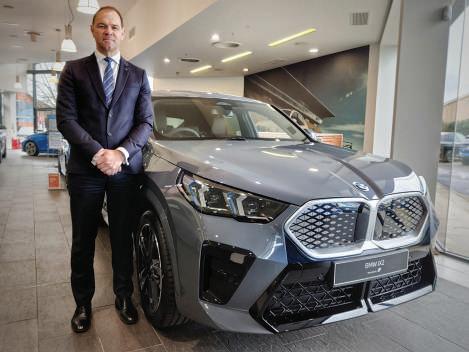
objective of ‘enhancing the corporate customer buying experience across the BMW & MINI retailer network’. Vertu was an early adopter and is now fully invested, aiming to provide the same premium certified customer experience to all drivers, whichever sales channel they come from.
The certified approach is highly valuable in how the Vertu Corporate team undertakes business and ensures customer satisfaction throughout.
The right information is presented at all stages of the process, offering insights into the latest BMW and MINI technology and building the excitement and expectation as new car day approaches!
When the much-anticipated car arrives with its driver, the customer is already some way accustomed to understanding the workings of their new car.
The Corporate Certified process provides a premium handover experience in a BMW or MINI centre that is most conveniently located
Continued from page 27
Being honest, there aren’t many car brands whose interiors are as nice as those you’ll find in a BMW, and in that respect the iX2 scores highly.
A colleague pointed out that the iX2 comes with some fake engine noises, but if we’re being honest, it doesn’t feel like a car that should.
This is a comfortable, well balanced, family motorway cruiser with everything built in to make your life easier.
Pros
The iX2’s coupé looks make it stand out from the crowd. Company car drivers will love the 2% BIK. The high-quality interior and infotainment system will make every journey a pleasure.

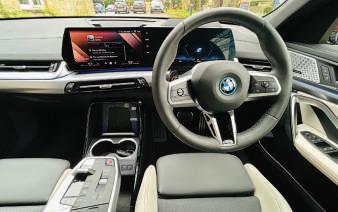
Cons
The iX1 is cheaper and more practical. The iX2 may look the business but it’s not as much fun to drive as an i4.
Conclusion
BMW has added another excellent electric car to the range. Although it’s not quite as practical as the iX1 nor as cheap, we think it’s
Iain McLennan, Corporate Director, Vertu BMW & MINI.
“The Vertu Corporate department specialises in all areas of the corporate marketplace, from supplying into public sector, national end user, local owneroperated business and also into the numerous FN50 leasing companies...”
for the customer. In circumstances where this isn’t possible, Vertu provides a fully enclosed trailered delivery solution with BMW branding and trained drivers. These drivers finish the experience, ensuring that they only leave when the customer is comfortable with all the controls. The Corporate team will also contact the customer within 48 hours of the customer’s car handover to ensure that everything is going smoothly and to answer any questions.
From the 100% electric i range to petrol and hybrid motoring options, the Vertu team is confident of finding the perfect match to meet your business needs. Providing tailored support to fleet managers, company car drivers and leasing companies, the Corporate Certified team at Vertu BMW and MINI is dedicated to facilitating your fleet aspirations, no matter how big.
Get in touch with the Vertu team to learn more about how its BMW & MINI corporate solutions can benefit your business today.
a premium worth paying for a much more attractive stand-out car.
To save cash, go for the kit level offered by the eDrive20, which is excellent and offers a bigger battery range as well. If you are looking at comparisons, then the Tesla Model Y and Polestar 2 definitely give it a run for its money on the road, but neither feels as premium as the BMW.
Top of the Bundesliga. Sporty looks are a head-turner, good range and good drive, too. Even better is the jaw-dropping BIK, at just 2 per cent
CC&V RATING: N N N N N

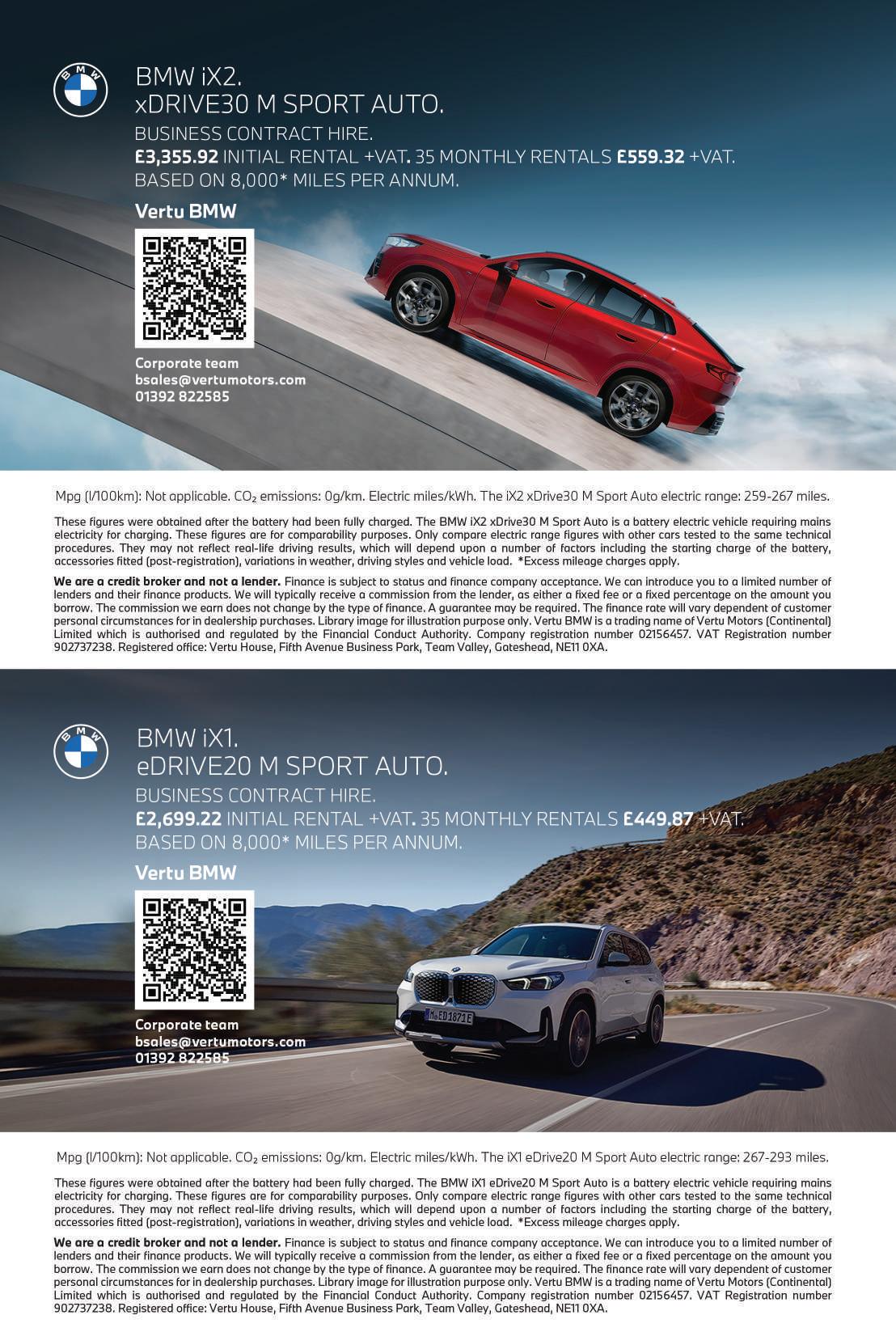
CC&V: The arrival of EVs has completely changed the fleet sector. What strategy does BMW have to capitalise on fleet electrification while not ignoring those who are not ready for the change?
MC: BMW 330e, 5 Series, X5 and 7 Series PHEV models are all proof points that we have numerous tax-efficient options available to corporate customers not yet wanting to make the switch to a BEV. We offer our customers the choice of drivetrain across the range, whether BEV, PHEV or ICE.
The addition of new-generation MINI models this year provides additional variety and choice at a wider spectrum of price points.
It’s more than just the products when you electrify: it’s BMW Charging Card, but also App integration to make the transition seamless; it’s Proactive Care throughout the life of the vehicle; it’s being able to monitor and promote sustainability credentials; it’s about FleetData for managers to monitor. We’re focused on providing more than just EV models, it’s about a holistic support structure.
CC&V: Many of our readers are electrifying their fleets but for some, PHEVs are a good compromise. You’ve just launched a new 5 Series PHEV, so will BMW continue to offer a plug-in hybrid range across its most popular corporate models or are there any plans to phase these vehicles out?
MC: Plug-in hybrid models remain an important cornerstone of our business globally and in the UK. Our goal is to offer the choice of models and powertrains, so that they can choose the option that best supports their needs. BMW 530e and BMW 550e are available for their first media test drives, and you will see more investment in our plug-in hybrid model range with announcements to come in spring this year.
BMW provides not only a single PHEV option in each model, but a range of options (eg, 530e or 550e) where we can. This is a stepping stone for many fleets looking to electrify or reach net zero gradually, and we have no plan to phase them out while they are proving popular and offering tax advantages vs. ICE.
CC&V: There’s a new Mini Countryman out for 2024, with an electric version due later this year. With low BIK, the electric Countryman should appeal to many in the corporate sector. Do you have hopes for it in fleet?
MC: One of the most exciting parts of next-generation MINI models are the new
“If you look at the trends in the sector, I don’t see any aspect where BMW and MINI are not already well positioned to capitalise and grow – but also manage the transition effectively”


BEVs – both Cooper and Countryman. The Countryman sits in a rapidly growing segment (as we see with iX1) so offering a MINI as a viable fleet option is very exciting. Many of our existing MINI customers very pleased to see this development and expanding range.
CC&V: The BMW i5 deservedly won a 2024 Company Car & Van award as our Large Electric Car of the Year. How has the i5 been welcomed in our sector so far and will the launch of an i5 Touring add an extra string to your bow?
MC: It’s been a very positive reaction: lots of positive first drive and group test feedback via the press, and we’re encouraged by the reception from fleet media. It’s been a real generational change with the 5 Series and we’re grateful for the external recognition of how far our technology has advanced.
We expect around 15% of fleet 5 Series customers to opt for the Touring model, so it’s great to be launching with the i5 variants first, with PHEV models closely following. Equally important and not to be missed, we’ve also launched the i5 Sport Edition for both Saloon and Touring. This provides a new entry-point into the range and greater eligibility across company car bandings.
CC&V: Last time we met, ‘agency sales’ was a topic of discussion. With rumours that BMW are slowing down the implementation of this, if or when it goes ahead, could it affect your fleet customers’ relationship’ with their local BMW corporate dealer?
MC: During the past two years, we have been working towards changing from a wholesale model to an agency model. In January 2024, the Swedish, Polish and Italian MINI markets made this change to the agency mode. We call this approach ‘The New Retail’ internally, and it will deliver, among other things, a seamless customer journey, price consistency and an omni-channel sales experience that will benefit our customers

and provide the foundation for our future success.
The BMW brand will join in 2026 and the exact transition dates for our brands in the UK will be revealed in due course.
We have always been clear in our discussions with our UK network that we will work with them and flex roll-out appropriately. There is less impact for the corporate side of the business since we already operate a direct sales model for most customers, and that includes local business handled by retailers.
The corporate customer journey will also be enhanced as part of The New Retail, however, and we look forward to sharing more about that in due course.
CC&V: Finally, where do you think BMW will be positioned in the corporate sector in two years time?
MC: If you look at the trends in the sector – electrification of fleets, evolving charging infrastructure, salary sacrifice programmes, sustainability, Government-led changes via ZEV Mandates and Net Zero commitments – I don’t see any aspect where BMW and MINI are not already well positioned to capitalise and grow – but also manage the transition effectively.
The next two years are key for our product portfolio. There is an all-new MINI family launching in 2024 and more to come in 2025. Then the next-generation BMW models to follow from 2025, with the Neue Klasse. These very fleet-relevant products will utilise BMW Group’s sixth generation of lithium-ion battery cells, which represent an enormous technological leap.
The energy density will be improved by more than 20 per cent, charging speed enhanced by up to 30 per cent and range improved by up to 30 per cent. CO2 emissions are reduced by up to 60 per cent in the production of the battery cells too.
Andrew Walker
Toyota has updated its C-HR crossover for 2024 with improvements all around - though it retains its unquestionably stylish looks in a sector of vanilla blandness. We checked out the range-topping GR Sport...
Engine choice
Two petrol hybrids, a 1.8 138bhp petrol and the larger 2.0 litre 194bhp version. The 1.8 comes with a top speed of 106 mph and takes 10.2 seconds to reach 62mph. The 2.0 litre will hit a top speed of 112mph and 62mph in 8.1 seconds. Plus a plug-in hybrid awaits, with a claimed electric range of up to 41 miles.
Specifications and model range
The C-HR is offered in four specifications: Icon, Design, Excel and the GR Sport. The entry model has 17” alloys, an 8” touchscreen, 7” driver information screen, Apple CarPlay and Android Auto, a reversing camera, LED headlights, adaptive cruise control, lane keep assist and road sign assist.
MPG and CO2
Both the 1.8 and 2.0 litre hybrid engines are both frugal. The 1.8 Icon comes with a combined economy of 60.1mpg and 105g/km of CO2 emissions, while the larger 2.0 offers a combined economy of 57.7mpg and

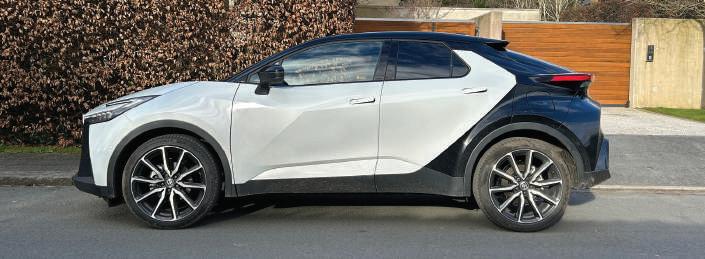
emissions of 110g/km.
Outside and in
The updated C-HR looks like the old C-HR but better, which is good thing. The range topping GR Sport has two-tone colour way, while the whole range =still features a low roofline to give it a five-door coupe-look.
Build quality inside is excellent, as is the infotainment system. The glove box is small, but you do get two centre cup holders and space underneath the armrest with good sized front door pockets.
Comfortable ride and decent handling, with all four passengers benefitting from the supple suspension and lack of body roll that’s
on offer. There are three driving modes: Sport, Normal or Eco modes. Not much between them but Sport definitely the most enjoyable. Adaptive cruise control made longer journeys relaxing
The updates have definitely improved it. It still looks great but now comes very well equipped, with the latest tech & safety featuring across the range. Fleet customers will be happier with the updated hybrid version’s improved economy and lower emissions. When it arrives, the plug-in hybrid will be even more appealing to corporate customers.
RATING:


Andrew Walker
China leads the world in battery manufacture so it’s no surprise that we are now seeing some top Chinese car brands in the UK.
The latest to enter the fray is BYD. Founded in 1995, it is now the world’s leading manufacturer of new energy vehicles, with 28 years of battery expertise under its belt. It may be a name you are unfamiliar with but it sold 1.86 million electric vehicles in 2022.
BYD – also known as ‘Build Your Dreams,’ – has three models on sale in the UK:
DOLPHIN, ATTO3 and SEAL. We ran the rule over the ATTO 3. It’s a front-wheel drive C-Segment SUV. Built on BYD’s e-Platform 3, it features a Blade Battery that’s designed to be more efficient as well as lighter.
Exterior
Designed by Wolfgang Egger, the Atto 3 has elements of Chinese culture embedded into the design. The front has a hint of a dragon’s face, with LED headlights and a horizontal grille symbolising the mythical creature’s eyes and moustache. The rear features a full width LED light bar, similar to those found on the Mercedes-Benz EQ.
Interior
Here’s where things get interesting. BYD could have played it safe but has decided to mix things up a bit, and all credit for that. Unique gym-inspired design touches, such as the barbell-style door handles, kettle bell-style gear selector and free-weightstyle air vents are joined by red ‘banjo’ strings which are attached to the doors between the speakers and the door fronts. It looks great and is refreshingly different.
Model range and prices
Three choices on offer. Entry level Active costs £36,490, Comfort £36,990 and range topper Design retails at £38,990.
All versions get a panoramic sunroof, aluminium roof rails, 18” alloys, LED lights, daytime running and taillights with high beam assist, as well as heated front seats, two front and two rear USBs, 5” LCD instrument panel, a rotary touchscreen, 8-speakers and Adaptive Cruise Control.
Dominating the dash is a portrait touchscreen with a difference. It’s rotatable, 12.8” on Active and Comfort, 15.6” on Design. Simply touch the screen icon and it will rotate to landscape or vice versa. The DiLink 4.0 4G system features voice recognition, integrated Apps including Apple CarPlay, SatNav, DAB, Over Air Updates, 8-speaker audio and smartphone wireless charging.
Warranty
The battery has an eight-year or 120,000

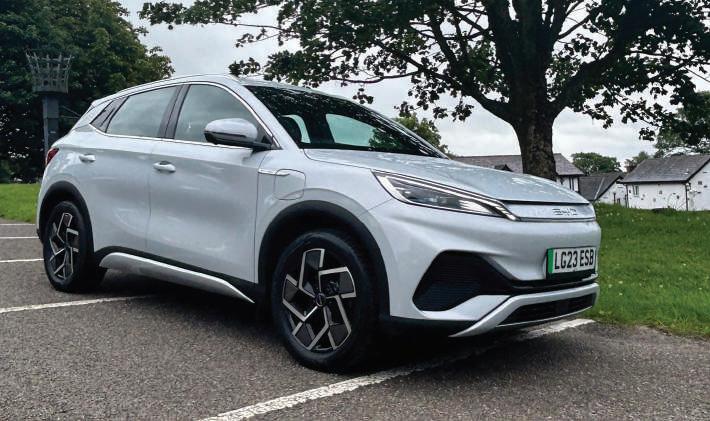
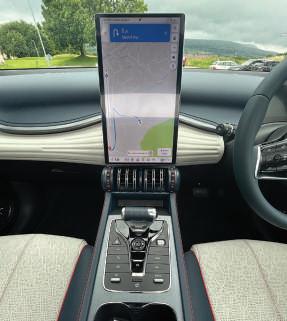
mile warranty, SOH 70%. Motor/electric control: 8 years or 90,000 miles. Bodywork (anti-corrosion perforation): 12 years. Complete vehicle warranty: 4 years or 70,000 miles.
Practicality
The cabin may be different but it’s practical. Generous head and legroom, a boot with a 440-litre capacity rising to 1,338 litres, and plenty of in-car storage
Charging, range and battery
Atto 3 has a WLTP electric range of 260 miles, with energy consumption as low as 3.98 miles/kWh (WLTP) and 5.17 miles/kWh (city). Charging power is 11 kW AC 3. With a 150KW DC charger, the battery can be replenished from 30% to 80% in just 29 minutes. The 60kWh battery would take 6.5 hours to charge at home. All models are also equipped with VtoL so external devices can easily be charged by the car battery.
The Atto 3 accelerates from 0 to 62 mph in just 7.3 seconds. With 310 Nm of torque, top speed is 99 mph. It has four driving modes: Sport, Normal, Economy or Snow. The regeneration adds a little bit of a pull on the car but isn’t one-pedal driving. It will squeeze a few more miles from the battery.

The ride isn’t too unsettled but it was fidgety on certain surfaces. On the plus side, the steering is well balanced and on the heavy side, which we prefer. On a series of switchbacks and hair-pin bends, the Atto performed admirably and when required on a wet road, stopped quickly, too.
Pros
Very well screwed together and offers something different. It drives well, looks pretty good and comes with all of the latest tech and safety features as standard. Competitively priced, zero emissions and just 2% BIK for fleet customers.
Cons
Externally, possibly a bit safe and in common with most EVs is a little unsettled over poor road surfaces. Funky interior may not be to everyone’s tastes.
If you’re looking for a reasonably priced electric car, then the Atto 3 could be for you. Utilising BYD’s battery technology, the first car from the Chinese corporation won’t set your heart on fire but it will appeal to those seeking a well-equipped, spacious electric family SUV. Offers something just a little bit different, especially with a cool rotating touchscreen and a design ethos that’s refreshingly different. A quick look at the UK dealerships selling BYDs should give you a clue, with the majority selling it alongside more established premium brands whose cheapest electric cars cost an awful lot more than the Atto 3.
CC&V RATING: N N N N

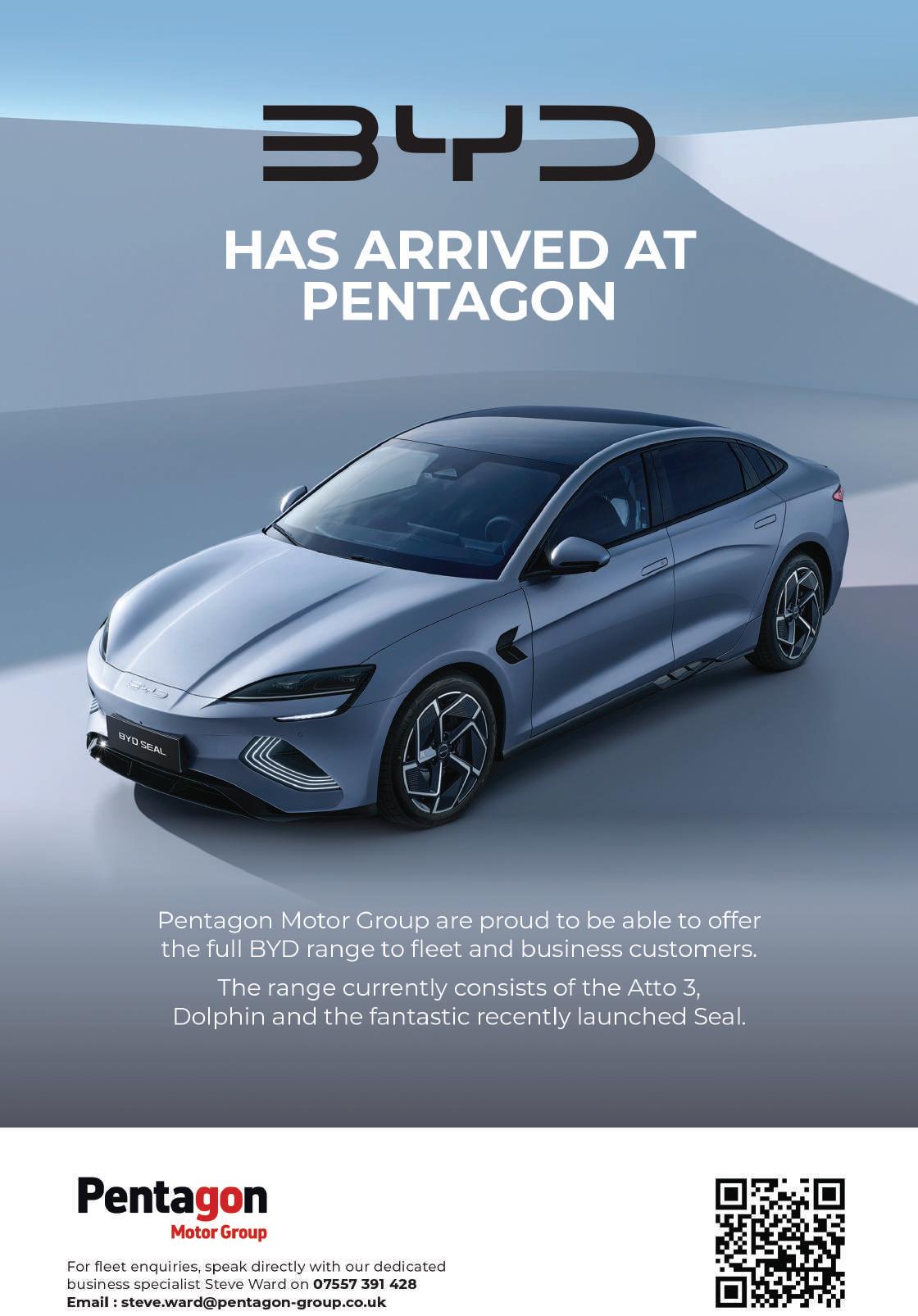
Lookers has recently opened its third BYD dealership in the heart of Sheffield.
The Group has put the Chinese electric brand into a newly refurbished state-of-theart facility, enabling its customers to immerse themselves in the BYD brand and see for themselves why ‘Build Your Dreams’ is making waves in the automotive industry.
Lookers is an established and trusted name in the automotive sector and has been partnering with some of the most iconic brands since 1908, with BYD the latest to join the list.
In the final quarter of 2023, BYD overtook Tesla to become the world’s biggest electric car company. Since its launch BYD has sold over six million ‘New Energy Vehicles’ worldwide, and was the first major manufacturer to stop production of internal combustion engine vehicles and focus solely on EVs. This was a real step forward in helping the brand aspire to lowering global temperatures by 1 degree C.
But BYD isn’t resting on its laurels. It is the official E-mobility Partner for the UEFA EURO 2024 tournament, illustrating its intent and current ambition to spread the brand name across Europe. You may also have seen BYD on Saturday night TV where it has partnered with Ant & Dec’s Saturday Night Takeaway.
For the car aficionados out there, BYD has also confirmed its attendance at this year’s Goodwood Festival of Speed.
All of this is helping establish the brand, but what about the cars?
The UK line up currently consists of three all-electric models from the company’s Ocean Series: DOLPHIN, ATTO3 and SEAL. There will be a minimum of two more vehicles added to the range before the end of 2024.
To reassure electric customers, all BYD vehicles come with the manufacturer’s six-year 93,750-mile warranty, with the battery covered for up to eight years or 125,000 miles.
Are the BYD cars any good ?
If the recent list of accolades and awards is to go by, then yes. Both the BYD DOLPHIN and the BYD SEAL reached the last three rankings at the 2024 World Car Awards, setting a new benchmark for the prestigious competition. The list of awards for all three BYD cars is growing, with the SEAL also winning the Company Car & Van One to Watch for 2024.
BYD is now a serious contender in the electric car sector, offering industry-leading battery technology, fantastic design, value
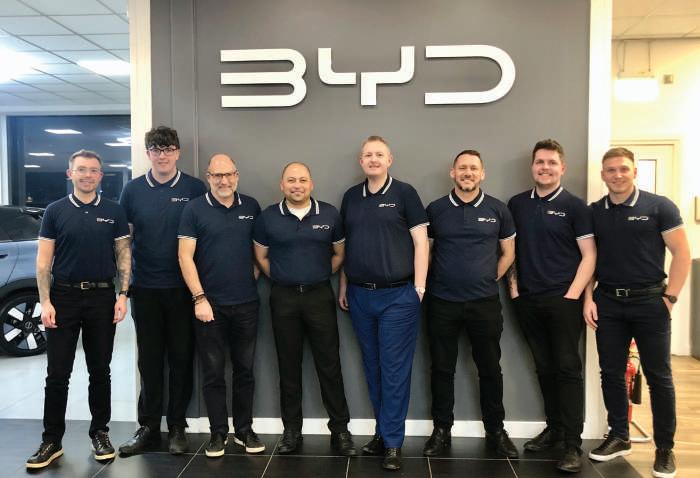


for money and excellent build quality across the range. With all this in mind, it’s easy to see why so many fleet and company car drivers are taking a long and serious look at what the BYD has to offer.
Partnering with Lookers has enabled BYD to utilise the Group’s large Fleet and Corporate Business operation, with significant sales already generated through this channel, with nationwide delivery available.
If you’re a fleet or business customer looking at contract hire, leasing, outright purchase or salary sacrifice, BYD has a model for you. Why not call in or contact Lookers BYD Sheffield, where you’ll find the full range of BYD vehicles available for customers to

test drive and a wealth of knowledge on the brand and its world-leading technology.
Lookers Sheffield BYD offers all retail facilities including Motability where currently the ATTO3 & DOLPHIN range are available with NIL advance payment.
Lookers also offers the reassurance of fully trained EV Master Technicians and with the brand’s ever-growing aftersales network BYD is really shaping up as a serious choice for company car drivers and fleet customers.
For more information contact
Lookers BYD, 10 Savile Street East, Sheffield, S4 7UQ.


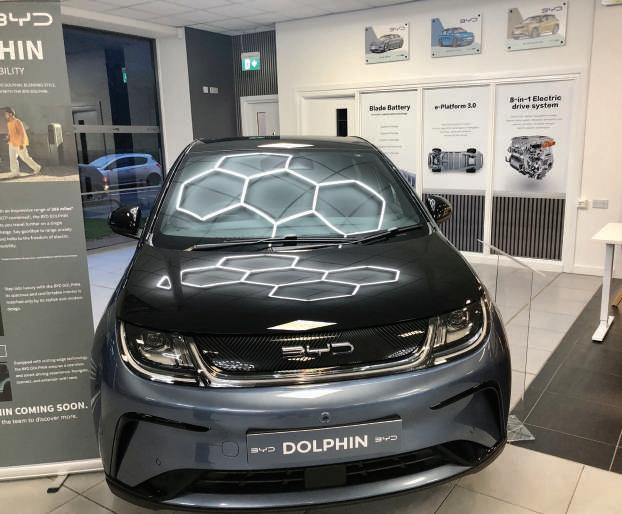


Launched at the CV Show in 2023, the Maxus eDELIVER 7 is a mid-size electric van that sits between siblings the eDELIVER3 and eDELIVER 9. Andrew Walker spent an informative day at Maxus HQ in Liverpool learning all about the new van
Model range
It’s available in three sizes, L1H1, L2H1 and L2H2, with two battery choices, 77kWh or 88kWh. L1H1 and L2H1 are available with both batteries, while the larger L2H2 is only offered with the 88kWh battery.
Payload and capability
The L1H1 with the 77Kh battery has the largest payload, at 1,200kg. The L1H1 /88kWh battery combo has a payload of 1125kg while the larger L2H1 / 77kWh offers a 1135kg payload, the 88kWh, 1055kg, and the L2H2 /88kWh battery, 1025kg payload. All tow up to 750kg. See panel right for dimensions.
All versions feature a steel bulkhead with an observation window, rear wing doors with 90°/180° opening and 6 tie-down loops.
Power and performance
Maximum power with both batteries is 150kW and maximum torque is 330Nm. Top


speed is limited to 55mph if you drive in ECO mode, or 75mph in Normal or Power mode. It will take 10.8 seconds to go from 0-62mph.
Charging and range
At home on an 11Kw AC charger you’ll be able to charge your eDELIVER 7 77kWh battery, from 5-100% in eight hours. A 90kW DC charger goes from 20-80% charge in just 43 minutes. The 88kWh battery is a little

slower, at 9.3 hours at home and 43 minutes for a rapid charger.
WLTP combined ranges are 200 and 230 miles for the 77kWh and 88kWh batteries respectively.
Technology and comfort
All models feature a 12.3-inch touchscreen infotainment system with Apple CarPlay and Android Auto, MP5, DAB, Bluetooth, a single

L1H1
Volume: 5.9m3 Length: 2547mm
Width: 1800mm Height: 1390mm.
Side sliding door: 900mm wide
L2H1
Volume: 6.7m3 Length: 2913mm
Width: 1800mm Height: 1390mm
Slide sliding door: 990mm wide
L2H2
Volume: 8.7m3 Length: 2913mm
Height: 1693mm Width: 1800mm
Slide sliding door: 990mm wide
USB input, a 12v socket and 4 speakers. You also get a heated steering wheel, manual air-con, one touch start, automatic LED headlights, a heated windscreen and front and rear fog lights. There is the option of a two-seat passenger front bench or a single passenger seat. Safety features are incredibly comprehensive.
Dash and controls can best be described as sparse but it does give you a decluttered look. In front of the driver is a clear and concise digital display with battery charge, your speed and vehicle range. Steering wheel controls allow you to adjust the infotainment, receive a hands-free phone call and set the vehicles cruise control function. Apple CarPlay is offered via the single USB, useful for our iPhone and Apple Maps.


Driving the eDELIVER 7 is a doddle. It feels like piloting a large SUV. Climb aboard, push the start button, select Drive and away you go.
We began in Eco mode which limits your top speed to 55mph. With two of us on board the van felt plenty powerful enough. It was also eerily quiet.
There are three levels of regeneration available, with High adding a bit more accelerator weight to the drive; it would be great in town or stop-start driving situations. Low gives the van a little more oomph, useful for the motorway.
As far as comfort goes, the seats are nicely adjustable, all of the controls fall easily to hand and the bonus of a heated steering wheel and heated seats mean you can utilise both to keep warm and will save draining battery power via the climate controls. The
only negative we could find is that the steering wheel does not adjust for reach, only up and down.
Pros
Comfortable and spacious interior. Fantastic safety. Neat and tidy dashboard with large, bright and clear infotainment. Two batteries, two heights, two lengths and a one-tonne payload gives operators a decent choice. A 200 or 230-mile driving range is ultra-competitive.
Cons
No chassis version yet. Even the entry level version isn’t cheap. Pricing starts from £44,995 + VAT for the L1H1 77kWh version, rising to £49,995 + VAT for the larger L2H2 88kWh model.
The step up in quality is clear to see and eDELIVER 7 joins the eDELIVER 9 as one of the nicest electric vans out there. Maxus has tried to cover as many bases as possible, with two heights, two lengths and battery options, so there will be a package that suits you. Only Vauxhall sold more electric CVs than Maxus, so they’re definitely heading in the right direction.
CC&V RATING: N N N N



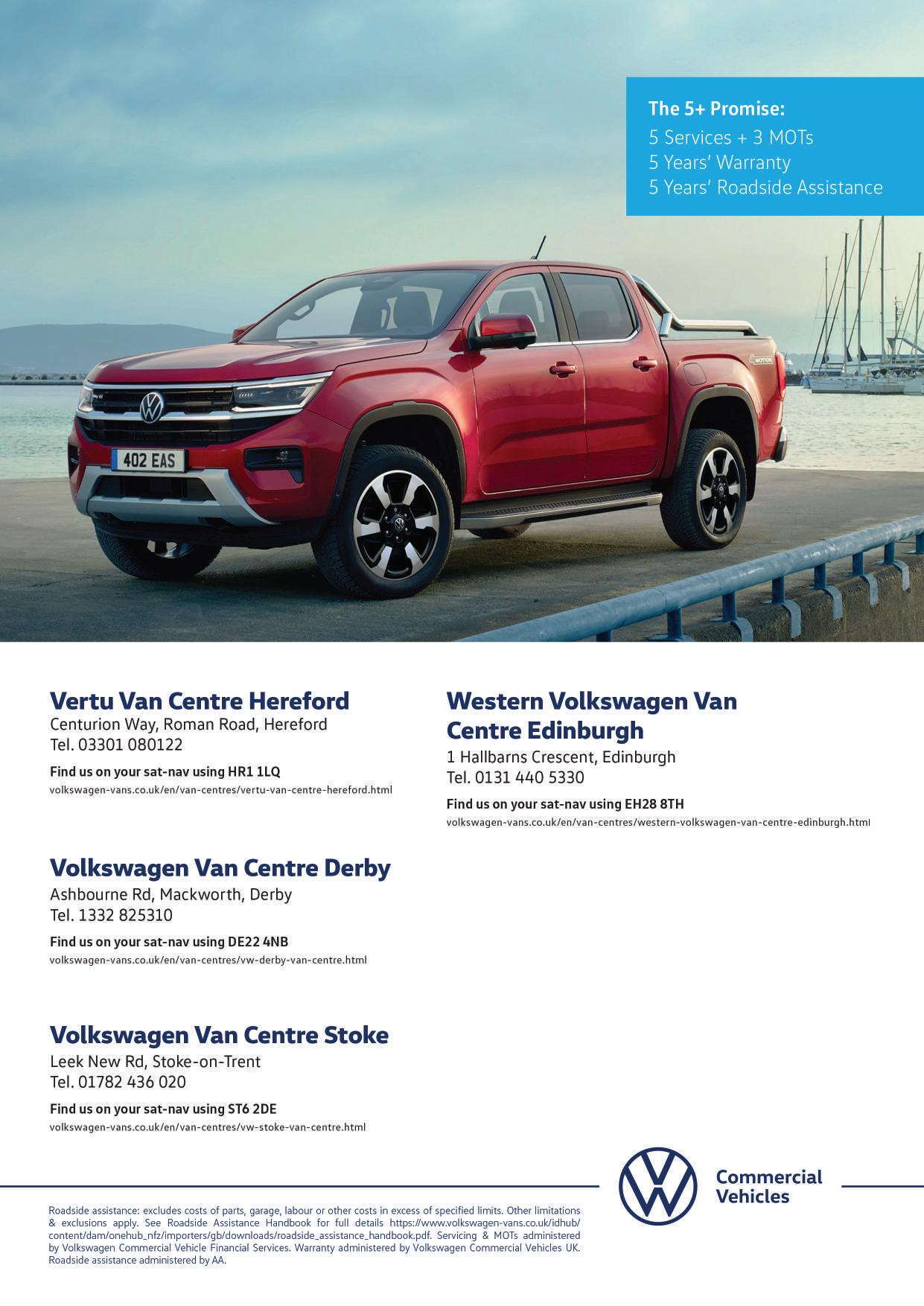
Although sharing much with the Ford Ranger, Volkswagen’s latest Amarok offers customers a Teutonic take on the pick-up, with just a double cab offered and specs including the exotically named PanAmericana and Aventura. Andrew Walker drove one recently, and here’s how he got on...
Models and engines
Choose from four specifications : Life, Style, PanAmericana and Aventura. The Life is the only model offered with the 2.0-litre four-cylinder diesel engine, paired with either a six-speed manual gearbox or 10-speed automatic transmission. Style offers a choice of 2.0-litre diesel or 3.0-litre V6 diesel engine, both with a 10-speed auto box. PanAmericana and Aventura versions only feature the 3.0-litre V6 diesel, again with the 10-speed auto. Every model comes with VW’s 4MOTION 4WD as standard.
Specifications
Life cost from £34,000 + VAT and is fitted out more basically then the other models. So you get cloth upholstery with vinyl flooring, 17 ” alloys, a 10” portrait infotainment touchscreen, Apple CarPlay, Android Auto and an 8” digital driver’s display. You also get a decent amount of safety and driver aids built in including adaptive cruise control, front and rear parking sensors, a reversing camera, lane assist and road sign recognition.
Style brings with it a price of £41,450 + VAT and posher micro fleece upholstery, carpets, 18” alloys, matrix LED headlights, a 360 degree parking camera, park assist, wireless smartphone charging, a 12” instrument display touchscreen and a roll hoop in the load bed.
PanAmericana, which starts from over £47,000 + VAT, is more aggressive looking with black alloy wheels and exterior trim, an X-themed grille, full leather, a Harman Kardon sound system, rear diff lock and an under body guard. Range-topping Aventura costs just over £48,000 + VAT and features larger 21” alloys, a heated steering wheel, plus more body chrome and silver trim.
Exterior
While what’s under the skin is very much shared with Ford, the outside has been designed to look different to the Ranger. The radiator grille is more conservative than its rival’s, with LED Matrix head and tail lights, Amarok embossed on the tailgate and unlike the Ranger, there’s no side step in the rear bumper.

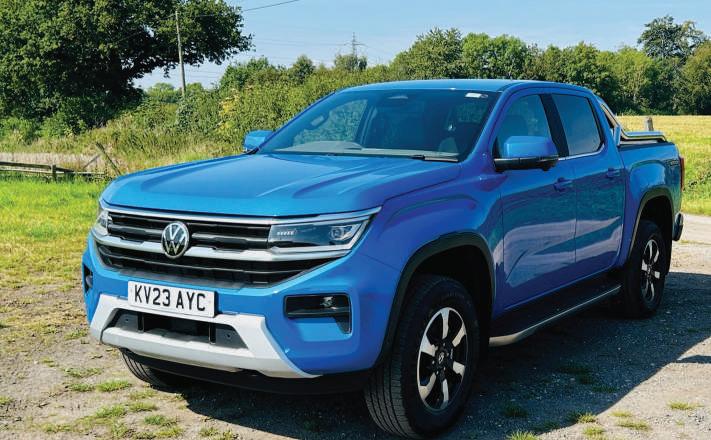

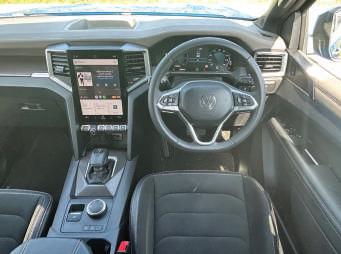
Inside
Again, while the dashboard set up and basic layout copies the look of the Ranger, the Amarok looks and feels more car-like. Underneath the touchscreen sits a selection of pushdown short-cut buttons for the driving modes, hazards and parking. The gear lever is centrally located with the twin cup holders pushed further back than in the Ranger. The steering wheel spokes, indicator stalks, air vents and dashboard trim and finish feel more upmarket as well as different from the Ranger, too.
The large portrait touchscreen runs off VW’s own operating system that will be familiar to Volkswagen fans. As a VW driver myself I found it easy to acclimatise too, although the climate controls are hidden within the screen menus so are a bit fiddly.
The graphics are excellent and responses are fast. The short cut buttons below get you into the driving modes: Normal, ECO, Tow/ Haul, Slippery, Mud/Ruts and DeepSnow/ Sand. There’s twin USB’s underneath so you can charge or connect your phone, with our

test Amarok featuring a wireless phone charger.
Pick-up practicality
A new feature is the roof load capacity of 350kg. Amarok is also longer than before at 5,350mm with a 173mm longer wheelbase of 3,270mm, which means passengers get more space in the cabin.
A selection of off-road and driving modes means you can toggle been 2WD, RWD, selectable and permanent all-wheel-drive.
You can choose your drive preference: from rear-wheel drive to selectable and permanent all-wheel drive with the preconfigured driving modes which are new as well. Amarok also comes with more than 25 assistance systems, over 20 of which are completely new on this Amarok.
The load bed measures 1.62 metres long by 1.58 metres wide, with a maximum width of 1.22 metres between the rear wheel arches, so it’s large enough to accommodate two Euro pallets. You can hold the pallets in place with the six lashing eyes, plus the bed area features a 12v socket and LED lighting. Add ons include load bed covers or electric roll covers.
Cabin practicality
The longer wheelbase does add a little more room, noticeably in the rear. Talking of the rear, there’s definitely room for three to sit side by side. Running boards and grab handles make getting in and out easier too. We’ve mentioned the twin centre cupholders. You also get a big glovebox and front and rear door pockets, dash top storage area, front

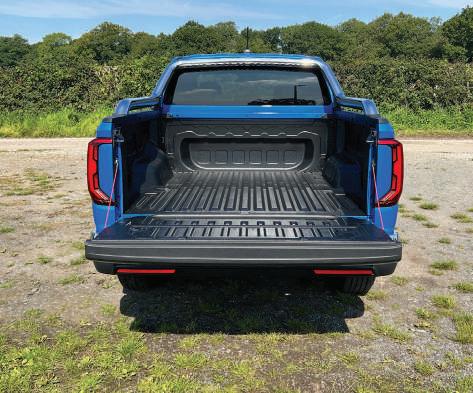
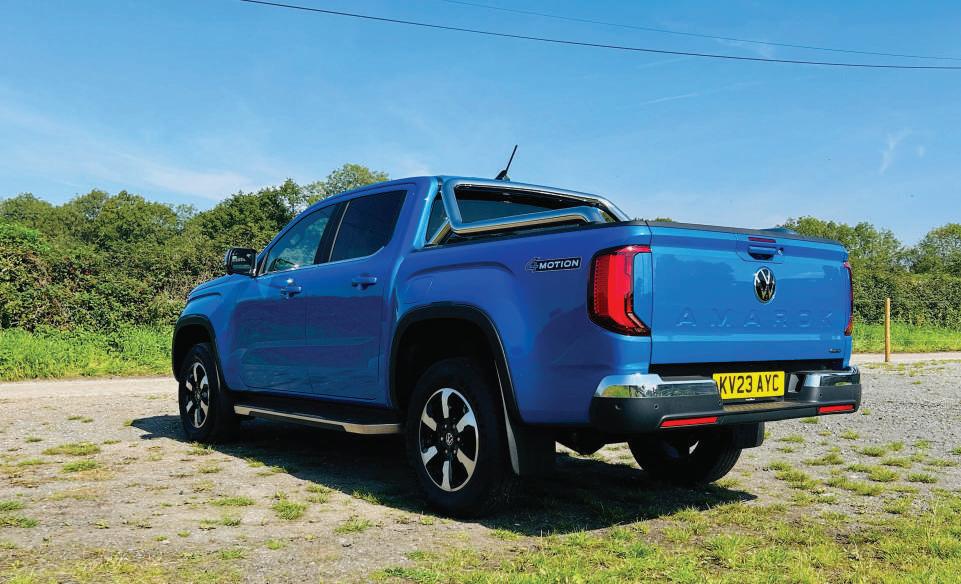
The gear lever is a little awkward to use. It features ergonomic buttons which have to be pressed by the fingers on your left hand to engage and change gear. We found it a bit fiddly, especially getting into reverse as you tend to go too far back into drive.
and rear 12v socket, two USBs up front, none in the back though and under armrest storage. There are air vents in the rear as well.
Select the 2.0-litre diesel manual and you’ll average 33.6mpg, with the 10-speed auto 32,8mpg, 32.1mpg in Style trim. Choose the 3.0 litre in any trim and it’s 28.3mpg. CO2 emissions range from 221-245g/km for the manual Amarok Life to 265-271g/km for the range-topping Amarok Aventura. Our 200-mile week in the 2.0-litre Style auto saw us return 32.3mpg.
Taxation
All versions have a 1 tonne payload bar Aventura, meaning this model is charged the flat rate of Benefit-in-Kind tax for LCVs, so one to avoid. All others qualify for the same annual Benefit-in-Kind rates, regardless of the list price. As we write these stand at £792 per annum for a basic-rate taxpayer, or £1,584 for a 40% earner.
The cabin is lovely place to be, so that’s a good start. The front seats are comfortable and there’s plenty of seat and steering wheel adjustment offered. Ford’s tabloid-shaped touchscreen looks good and works well in the Amarok. We would prefer separate climate control though.
Driving around our locale the 2.0-litre Amarok made steady progress, with the 10-speed auto box hanging onto the gears a bit as the revs rise before things settle down. Accelerate hard and the 2.0-litre diesel engine roars into life and becomes more audible in the cabin,
The changes between gear ratios are made fairly smoothly and despite its size and weight the Amarok handles undulating terrain with aplomb. The large tyres do account for a bit of vibration through the pick-up floor and there’s some road noise. Unladen it’s not too bouncy up front either, with only the poorest road surfaces offering an unsettling ride.
If you do venture off road, ground clearance is 219mm and if required, you can wade at 800mm (at 5mph). With an approach angle of 30 degrees and departure of 21, the Wildtrak will also get you pretty much anywhere you want to go.
On the motorway the Amarok is amazingly
proficient. Quiet, comfortable and with adaptive cruise control on all versions, you just point and go. My familiarity with VW’s operating system meant connecting to the Apple Car Play was easy and making and receiving some hands free calls in CarPlay worked well also.
Despite its weight and length, it’s actually a pleasure to drive and with parking sensors and a rear view camera, easy to park as well. It’s definitely an evolution from the previous model and feels both more grown-up and more modern.
The good
The Amarok is really nice to drive on road and is massively capable off it. Compared to the Ford Ranger, it is more car-like and the finishes feel more upmarket. If you’re travelling long distances, the Amarok is a really good long distance performer with plenty of room on board for five. You’ll benefit from low BIK if you avoid the Aventura. Load bed size and towing capacity are first rate.
The bad
Touchscreen climate controls aren’t the easiest to use. The gear lever is fiddly. The 2.0-litre engine is not as refined as the 3.0 version.
All versions are expensive and fuel economy of 30mpg isn’t wonderful.
Volkswagen has decided to forsake the working pick-up for a lifestyle one, and has done a very good job indeed. It may be bigger than before, but thanks to a host of standard safety and driving-aid tech it’s actually much easier to drive, handle and park than its predecessor. Build quality in the cabin shines through and despite being expensive, the monthly BIK of £66 – £132, if you lease one, is hard to complain about.
It’s a great competitor to the Ford Ranger and a pick-up we’d love to spend more time in.
CC&V RATING: N N N N N
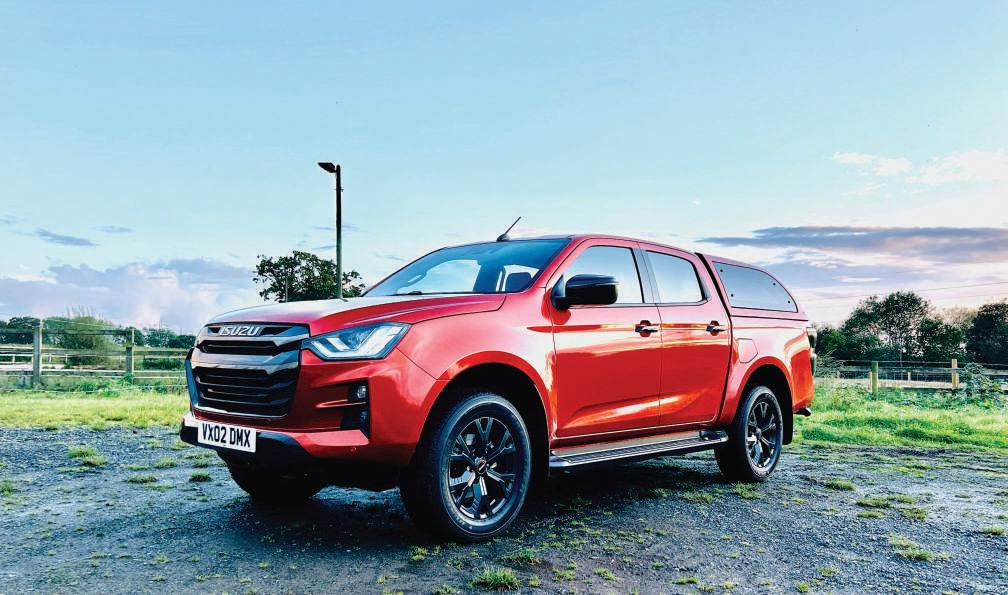 Andrew Walker
Andrew Walker
Isuzu’s new D-Max landed in the UK two years ago, at exactly the right time for the Japanese brand. As established players left the sector and others waited for their new models, Isuzu was able to increase its foothold in the burgeoning UK pick-up sector.
The previous D-Max range-topper, the Blade, had a reputation for toughness, reliability and durability. What was slightly lacking, though, was the more car-like interior, on-trend tech and safety features that some of its competitors boasted.
The former attributes are still there – this is a pick-up that will go almost anywhere –but updates mean it’s now improved where once it was lacking.
There are three options: Business, AllPurpose and Adventure. All have four trim levels – Utility, DL20, DL40 and V-Cross, to which you can add the steroid-injected Arctic Trucks AT35. We had the opportunity to drive the V-Cross from the Adventure range, the option that is leading the way in sales.
The 1.9 litre 162bhp engine has been carried over from the previous model. The ladder frame chassis, while similar to before, now comes with larger rails, additional bracing plus newer steels, all of which have contributed to make it a stronger pick-up. There’s a longer wheelbase, re-designed rear suspension, a shorter body, with increased load space both inside and out.
The updated D-Max now features a new front grille across the range and updated
wheel designs on the All-Purpose and Adventure models. The Business range has kept its durable steel wheels that are characteristic of the Isuzu D-Max Utility.
The 2023 model features two new colours, with the Dolomite White replacing the Pearl White and Biarritz Blue replacing the Sapphire Blue. The Biarritz Blue metallic paint finish is available on both DL40 and V-Cross models, while the Dolomite White pearlescent will be exclusive to the rangetopping V-Cross.
The hard-wearing cloth interior of the Business range models has remained, while the seats of the Isuzu D-Max DL20 are now covered in a more premium woven fabric with a refreshed design.
Moving up the range, both the DL40 and V-Cross have been upgraded with newly designed leather upholstery, which uses horizontal layering to create a more spacious feel. Moreover, a rear-differential lock option is now available on all manual 4×4 Utility models in the range.
Every version has a payload rating of at least 1,070kg, which is important for commercial vehicle tax purpose. There’s also a 3.5 tonnes towing capacity. Another interesting point is that every variant of the D-Max weighs under 2,040kg, meaning Extended and Double Cabs are subject to normal passenger car speed limits. Many double cab pick-up trucks – Ranger and Hilux for example – exceed this weight limit so must comply with goods vehicle speed limits, which are 10mph lower on single and dual
carriageways. It’s a fact that many pick-up customers are still unaware of.
All double-cabs get a radar system, with Isuzu choosing to use stereo-imaging via a pair of cameras at the top of the windscreen, enabling the AEB, lane keeping, traffic sign recognition and intelligent speed limiter to work more accurately than you will find elsewhere. The new system enables cross traffic alert, blindspot monitoring and emergency lane keeping, all new to the pick-up sector.
And if that’s not enough, Double Cabs get eight airbags, Single and Extended Cabs seven. On a 400-mile round trip we utilised the Adaptive Cruise Control and autonomous driving on the motorway, and it works brilliantly.
Pick-up emissions and fuel economy are not a selling point. V-Cross manual offers 33.6 mpg/auto 30.7 mpg with emissions of 220g/km and 241g/km respectively.
V-Cross certainly looks the part and features distinguishing new 18” black chrome alloys, very dark grey and black chrome radiator grille,‘Gun Metal’ side steps and door handles. It’s also very well equipped, with keyless entry and start, new leather upholstery, dual zone climate control, heated front seats, rear parking sensors, a reversing camera, Bi-LED headlights, LED front fog and an 8-way electrically adjustable driver’s seat. The 9” multifunction colour touchscreen is compatible with Apple CarPlay and Android
Auto and comes with eight speakers, plus front and rear USB ports.
There’s also an auto-dimming rear-view mirror and automatic headlight levelling. This is a pick-up tailored to the lifestyle sector.
The dashboard, fixture and fittings quality is excellent, with just a few cheaper plastics used lower down. The seat finishes are practical as well as hard wearing. More good news are the short-cut switches and stand alone climate controls which sit underneath the screen itself. No fiddling with complicated on-screen menus while on the move.
The infotainment system works wirelessly with Apple CarPlay and we were able to connect our iPhone to the V-Cross in about 30 seconds. As far as the touchscreen itself, the graphics are clear and response time is decent, too.
What’s it like to drive ?
The V-Cross is so much better to drive than the old Blade model, and is now competing with the latest Ford Ranger and Volkswagen Amarok. It handles the road more like a large SUV than a pick-up. It’s easy to drive and manoeuvre and also features excellent brakes. The latest seats are comfortable and coupled with the improved body structure, there’s far less body roll.
Rear passengers get more room and the rear seats are cleverly angled to make the rear more comfortable as well. On the motorway the V-Cross will cruise along happily at

motorway speeds without the previous model’s tendency to be very loud. The inclusion of ADAS means that you can select your speed and let the V-Cross do the thinking for you.
In town it is surprisingly agile and thanks to the reverse parking camera, easy to park as well. From start-up you do encounter a diesel growl and as you change up through the gears this continues until you hit the magic 25mph, at which point the cabin then becomes much quieter.
Excellent model choice of single, extended and double cabs. Isuzu prides itself on its ability to convert your D-Max to the likes of cherry-picker, by offering a bespoke service to suit the needs of customers.
Isuzu also has an extensive dealer network of pick-up experts to help you buy and service your D-Max.
The cosmetic upgrades only add to the D-Max’s appeal.
Cons
The 1.9 engine works fine in almost every situation, but it’s lack of out-and-out-pull could be an issue for some, and competitors do offer more oomph. A few cheaper plastics on the lower part of the dashboard. Rear seat passengers should expect a bumpy ride if loadbay is empty.
Conclusion
While other pick-up manufacturers have shied away from the sector, Isuzu is to be congratulated for making its very popular truck even better than before. The amount of choice across a range of single, extended and double cab models means that there is a D-Max priced for everyone.
Furthermore, the latest upgrades to the D-Max means that it now looks better than before, and our test V-Cross, finished in Valencia Orange, with a Truckman rear, gun-metal alloy wheels and after market addons, is definitely a contender for those looking for a lifestyle pick-up
Even better than before. Lots of choice and the latest upgrades mean it now looks better than before. Definitely a contender for those looking for a lifestyle pick-up.
CC&V RATING:
N N N N N


RVT Commercial Vehicles (RVT CV) has been named Isuzu Dealer of the Year for 2024 for its dedication to the brand and its commitment to delivering excellent overall performance, cementing itself as a leading player in the commercial vehicle industry and the Isuzu UK dealership network.
The Shrewsbury-based dealer truly demonstrated its capacity for success by also taking home Contract Hire Dealer of the Year, Accessories Dealer of the Year and Regional Dealer of the Year Awards.
RVT CV’s outstanding commitment to excellence, customer service and sales performance have warranted its name becoming synonymous with the pinnacle of Isuzu UK dealer success.
Isuzu UK registered its highest sales in one year since the launch of the D-Max, with RVT CV weighing in with the most sales across the whole of the UK dealer network in 2023, so it is no surprise that its success has not gone unnoticed.
Scott Thomas, managing director at RVT CV, stated: “We are incredibly honoured to be named as Isuzu UK Dealer of the Year for 2023. I cannot thank our team enough for the hard work and dedication that they have shown.
“At RVT Commercial Vehicles, we always strive to offer the best service and support
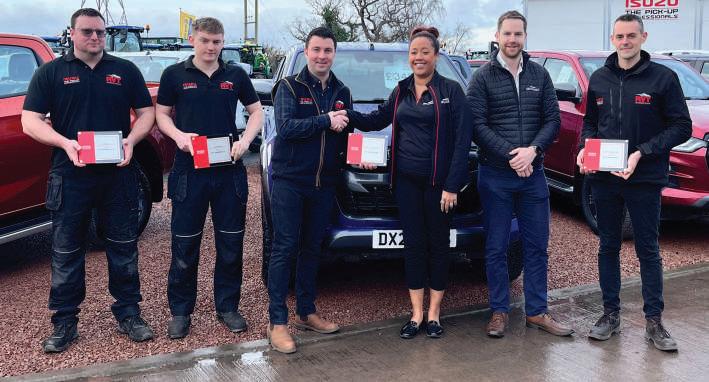
to our loyal customer base. Having received Regional Dealer of the Year in 2021 and 2022, we have made incredible strides to have won the awards that we have today.”
Isuzu UK’s regional sales manager, Dean Asplin said the awards were richly deserved: “It is absolutely to RVT CV’s credit that they have won this award.
“We work very closely with our dealers to ensure that they can operate to the best of their potential. In the case of RVT Commercial Vehicles, however, they have well and truly exceeded all expectations and have gone

above and beyond to achieve all-round excellence.”
Since 2017, RVT CV has been a proud partner of Isuzu, and this recognition further solidifies their position as a leading dealership within the Isuzu network.
Having founded the dealership for Shropshire and surrounding areas, the dealer is renowned for its service and support to local agriculture as well as the wider automotive industry. RVT CV looks to build on its impressive performance as it looks to improve its facilities moving into 2024.
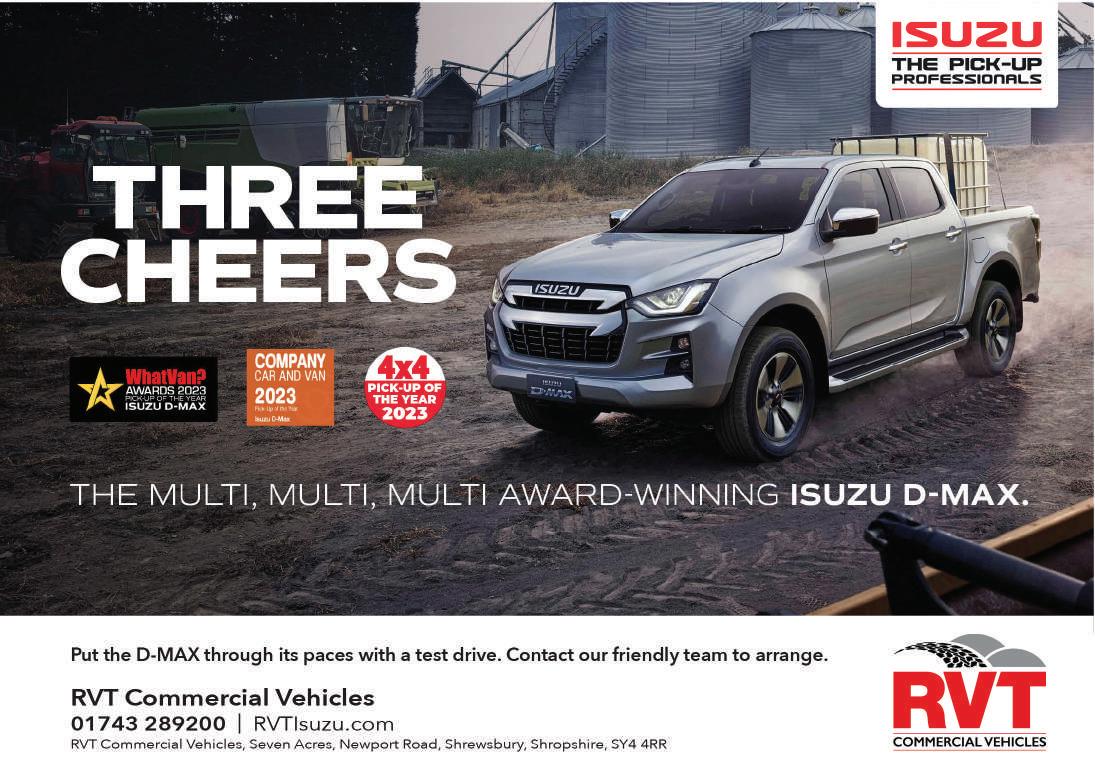
Andrew Walker
When the Nissan Townstar was launched back in 2023, we got an early chance to evaluate it thanks to our local Nissan Business Centre, Westway Nissan on Chancellor Lane, Ardwick in Manchester. Business Centre manager Rod Taylor explained that demand had been high for both the all-new petrol model and the Townstar EV as business operators begin to accelerate the transition towards electrification.
Townstar offers two powertrain solutions; one petrol and one fully electric. Townstar EV starts at £29,945 for a SWB version, while the entry level petrol Townstar costs from £19,475 (both + VAT).
Petrol engine
Nissan has kept it simple with just one 1.3-litre TCe engine and no diesel offered. It’s fully compliant with the latest Euro 6d-Full emissions regulations, delivering 130HP of power with 240Nm of torque.
Model range and payloads
Existing Nissan customers will be familiar with the trims on offer. First up is Visia, followed by Acenta, Tekna and Tekna+. There are also two Townstar wheelbases to choose from, either L1 SWB and L2 LWB. Payloads are up to 600kg (SWB) or 800kg (LWB), with the maximum braked towing capacity being 1,500kg. Load volume is 3.3 or 4.3 cubic metres and load lengths are 1,806mm for the L1 or 2,230mm for the L2.
The L1 can take a pair of Europallets and comes with a single sliding side door as standard. On the L2 models, the twin sliding side doors are wider, increasing from 615mm to 831mm; that’s wide enough load to pass a Europallet through them. Interestingly, whether you choose petrol or electric power for your Nissan Townstar, there’s no difference in the size of the load area.
All models get a full-width bulkhead, 60:40 split rear doors and a nearside sliding door to access the load area. L2 variants get an off-side sliding door as well. All versions feature a plastic bulkhead separating the cabin from the load area, but there’s no load-through option.
Standard kit on Visia models includes air-con, remote central locking with deadlocks, electric heated mirrors, automatic headlights and automatic wipers.
Acenta costs £1,000 more but adds an 8” colour touchscreen, Apple CarPlay and Android Auto smartphone connectivity, cruise control, climate control, rear parking sensors and AEBS automatic braking.
For an additional £1,300, Tekna adds SatNav, front parking sensors keyless entry and start and a useful rear camera.
A further £1300 gets you a Tekna+ with 16” alloy wheels and a suite of extra driver assistance tech, including 360-degree monitor, Park Assist, Blind Spot Intervention, traffic sign recognition and driver attention alert.


Townstar brings a suite of 20+ safety technologies to the compact van segment, such as Intelligent Emergency Braking, Hands-Free Parking, Intelligent Cruise Control and Around View Monitor (AVM).
Interior and storage
We’ve driven the Renault Kangoo which is ostensibly the same van, so we knew what to expect from the Townstar, and that we wouldn’t be disappointed. Quality is impressive, very car-like with good quality plastics and finishes throughout.
Storage-wise you get a small glove box, a dash top lidded box with two USBs and a 12v socket inside. The two door pockets are large enough for two drinks each. There are twin drinks holders in the centre binnacle and an armrest with storage space underneath.
The manual gear lever is nicely positioned in the centre of the dash with another 12v socket beneath.
The dashboard and steering wheel controls, left for cruise control, right for infotainment, are easy to use with separate metallic-ringed climate dials sitting underneath the touchscreen.
Helping you keep your eyes on the road ahead, Nissan has also included piano-key buttons under the central screen as short cuts to features such as central locking, ECO and, in our range topper, the all-around camera and parking functions.
Continued on page 46
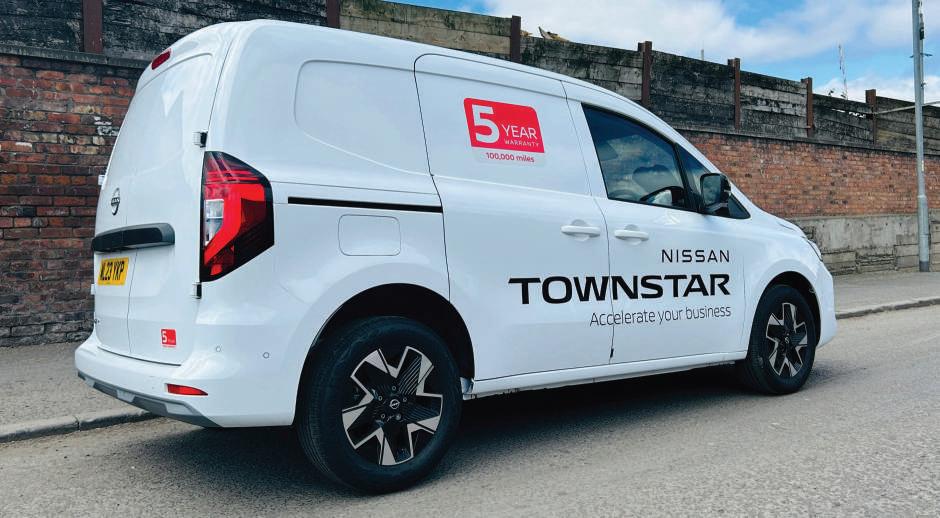


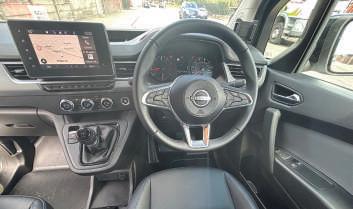
Continued from page 45
Fuel economy and emissions
The 1.3-litre petrol L1 can return between 38 and 44mpg on the WLTP combined cycle with emissions of 154 to 171g/km. The L2 is marginally less efficient.
Driving
We tried to emulate the experience most city van drivers would have – ie, slow-moving traffic and a couple of short hops on the motorway. The Tekna+ was very comfortable and very quiet. There is no diesel option, which as we head towards zero emissions makes sense, although Renault does have a diesel option on its Kangoo.
The six-speed manual gearbox is a doddle with a lovely, light clutch that made our urban journey a doddle.
We kept an eye on our fuel economy as it was a constant stop-start all the way out of the city and we were getting around 35mpg using the Eco button. On the motorway we hit Adaptive Cruise Control and let the Townstar go. Sitting on the inside lane at 70mph, the van was still remarkably quiet - that’s petrol for you – and after we drove half the length of the M60 the economy had jumped up to a very useful 41mpg. We drove back into town where traffic was light, and at the end of a 52-mile journey our overall economy read was 38mpg.
Negatives?
Perhaps the only issue with the 130bhp engine is that for some, it may be a little underpowered. Factor in two passengers and a rear load and the lack of power could be an issue. Room for taller drivers isn’t great.
Pros
Car-like interior and quiet cabin. Good fuel economy for a petrol engine and it’s reasonably priced across all versions. Being able to get a Euro pallet in the side doors is very useful on the L2. Excellent standard tech and safety on all models.
Massive improvement on NV200. Clever storage in the cabin and smooth sixspeed manual gearbox make it quiet and comfortable. Well equipped, good safety features. Takes the small van to a new level of comfort
CC&V RATING: N N N N N


Introducing the next-generation Nissan Interstar, the large van engineered and perfected to become the most cutting-edge addition to Nissan’s LCV portfolio yet.
With an increased size and versatility, it is also Nissan’s first large van with a full electric powertrain, with no impact on performance.
The perfect companion for the everyday hero
Tailored to meet the diverse needs of all businesses, the all-new Nissan Interstar prioritises efficiency, maximum capability and customer well-being. Boasting a design that exudes a truck feel, its assertive front grille enhances its commanding presence.
Interstar comes with a warranty of five years or 100,000 miles, or eight years or 100,000 miles for Interstar-e battery, ensuring peace of mind for every journey.
It also has a wide range of factory-built conversions, including Tipper, Dropside and Box Van. It’s a large van that is as diverse as its customers, and can take businesses of all sizes to the next level of efficiency.
Interstar-e
The all-new Interstar-e will deliver a more sustainable ride without compromising on performance. Its 87kWh battery provides a top range of over 286 miles. Nissan’s D/C Charging offers rapid recharging, up to 157 miles in just 30 minutes, and a shorter mission version with a 40kWh battery for approximately 124 miles. At the same time, its A/C Charging capabilities cater for depot charging from 10-100% in under 4 hours.
Whether you’re looking for additional battery autonomy or greater diesel fuel efficiency, the next-generation Interstar has got your back. The new model will be equipped with class-leading aerodynamics,


with a 20% Drag (SCx) Reduction, helping customers save either fuel or electricity and maximise their driving range and business efficiency.
The next-generation Interstar also boasts a 40mm wider side door alongside a 100mm longer load area, giving customers that critical extra room to pack in more of their goods and services.
Payload that delivers
Interstar also boasts serious payload competitiveness: 1.6 tonnes for the electric version and almost 2 tonnes for ICE options, making it all the more suitable for businesses needing to shift heavy-duty cargo.
Moreover, the four-tonne Interstar-e with a payload of 1.6 tonnes can be driven across Europe with a regular driving licence, allowing users access to a payload that is larger than more common 3.5-tonne diesel vans.
On the road
Manoeuvrability is also greatly improved, with an improved turning diameter that makes navigating tricky urban streets all the smoother, without losing load carrying.
Customer wellbeing is at the forefront of the Interstar. Standard safety features include Forward Emergency Braking, Drowsiness Warning and a Tyre Pressure Monitoring System. The Trailer Sway Assist is also included in this brand-new offering, for added security while towing goods.
As Nissan continues to power forward to a cleaner, safer, more inclusive world –including fully electrifying our LCV line-up from 2026 – the next-generation Interstar represents a crucial step on our journey, as we radically revamp a market legend to suit the myriad needs of our everyday heroes.
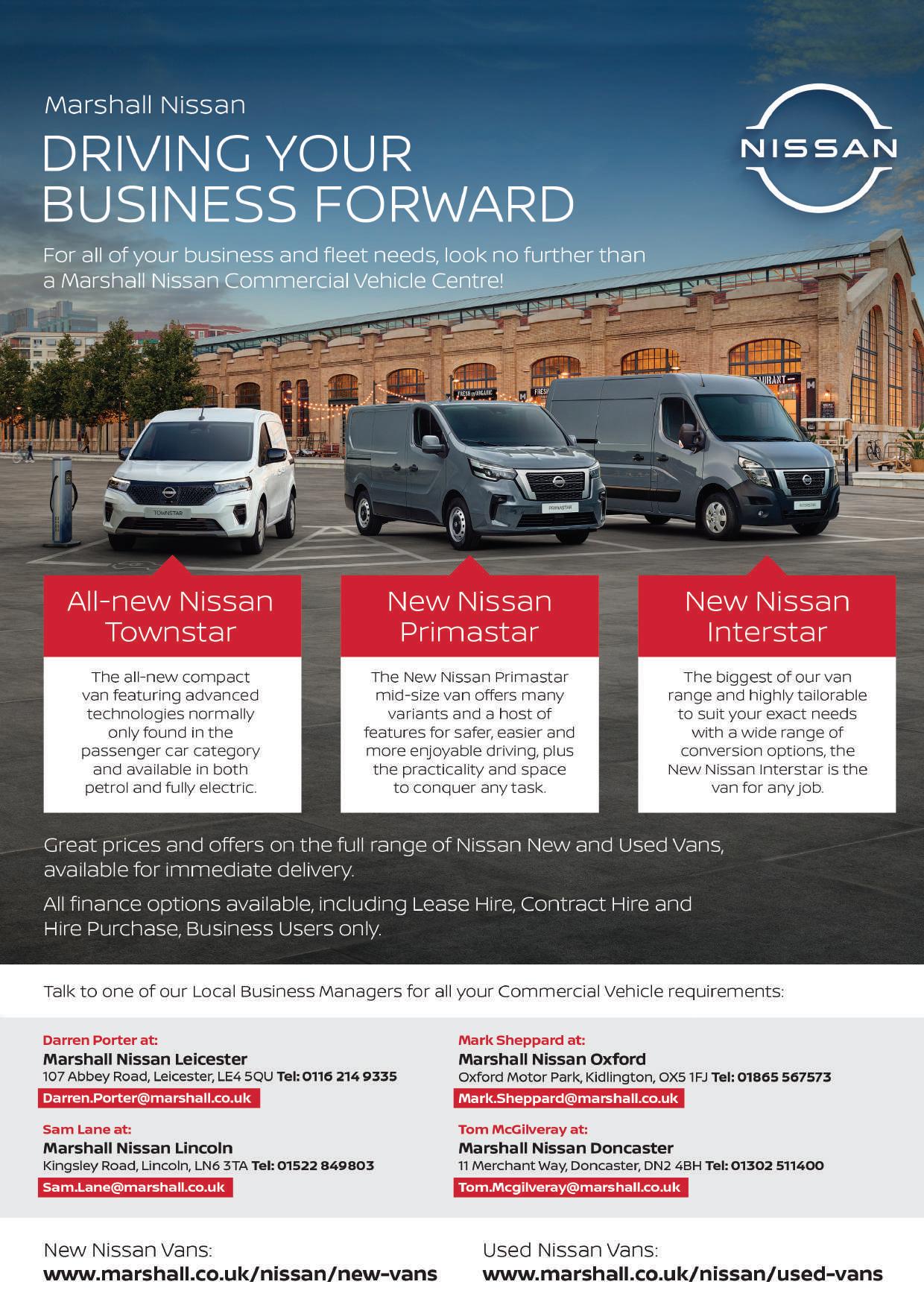
Lookers Ford has introduced a Commercial Vehicle Loyalty Club to help commercial operators with their vehicle requirements. It’s part of the dealer’s drive to offer the very best in service and offers for its clients, and brings a host of benefits for SME fleet managers and their companies. We spoke to Steve Thompson, head of Ford CV at Lookers to find out more
He told us that:
The Lookers commercial sales team are incredibly passionate about all things Ford and are there to help the business community choose the right vehicle for them, be it electric, petrol, diesel or plug-in hybrid.
For us, it’s not just about the initial sale of the vehicle but what comes before and after the sale has been agreed.
First, we will always spend time with our customers to make sure that the way their business buys from us is the right way for them. This could be contract hire, lease purchase or outright purchase and we will tailor the finance option that best suits you or your company.
Second, once your vehicle is on the road, the Loyalty Club is there for our customers offering the following services. These include:
■ Personal Account Handler.
■ One point of contact.
■ Basic tax information, ie, AIA (Annual Investment Allowance).
■ N1 enhancement advice.
■ Finance specialist on hand, with five finance options available.
■ Personal renewal bonus for existing customers.
■ Service packages – fixed cost motoring.
■ Mobile servicing.
■ Courtesy vehicles for our customers, whilst their vehicle is being serviced.
■ CAVI Commercial Alternative Vehicle loan for new warranty repairs.
■ Ford Pro vehicles, servicing, finance, charging solutions, software (Ford Live).
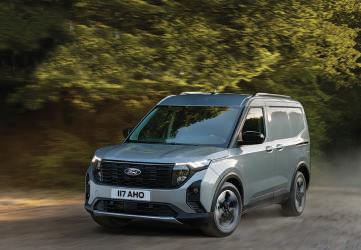

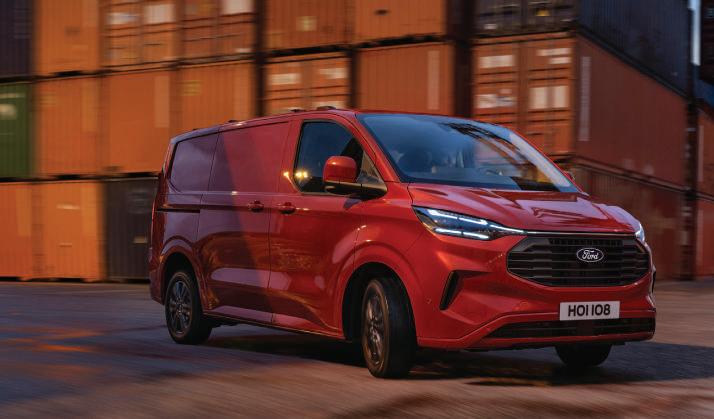
■ Customer Line of Credit for purchasing vehicles.
■ Extended test drives up to 48hours
■ The opportunity to drive all of Ford’s new award-winning models.
■ Nationwide delivery
Perhaps the most important concern currently amongst commercial operators, is the switch to electric. Steve and the team are able to offer customers advice in this area by utilising Ford Pro, the brand’s unique commercial vehicle programme, with telematics at its heart.
Ford Pro™ Software is a suite of digital tools built on real-time vehicle data, each designed to maximise operator productivity by delivering connected, always-on commercial vehicle and fleet uptime services.
It works by turning live vehicle health and telematics data into actionable information.
This means that Lookers can help improve your vehicle uptime, vehicle safety and vehicle security and manage your electric




fleet, improving overall productivity.
Depending on the size and specific requirements of your fleet, various smartphone apps and software platforms are offered in Ford Pro including Ford Telematics, Ford E-Telematics, Ford Telematics Essentials and FordPass Pro.
These allow customers to access a growing range of key productivity and vehicle uptime tools and subscriptions, which are increasingly important as the industry transitions to electric.
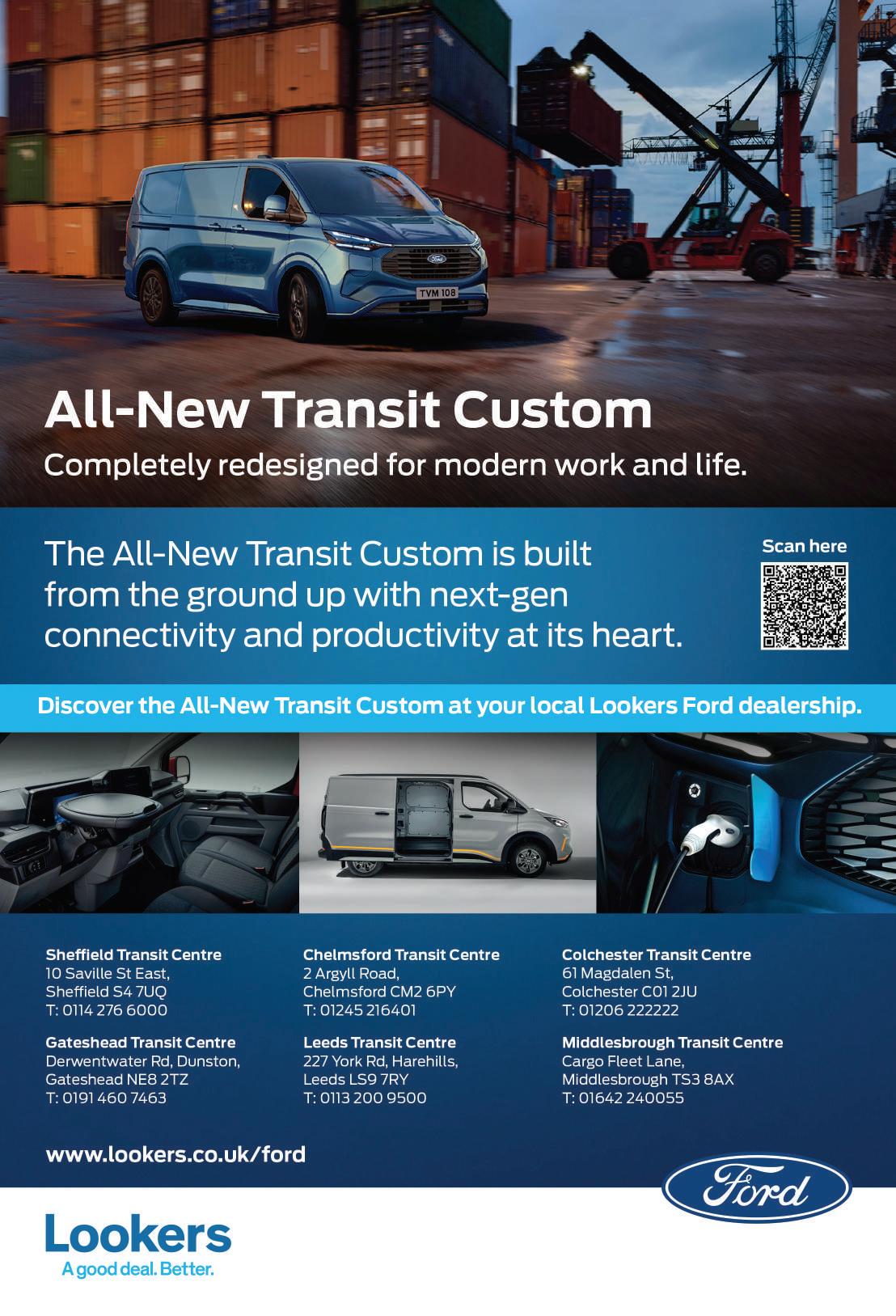
The all-new Ford Transit Courier is now delivering enhanced productivity and connectivity for customers, with the first examples of the lead-in Transit model now arriving across Europe.
To maximise productivity, Transit Courier has been completely redesigned around a larger and more flexible cargo area that delivers 25 per cent more load volume than the outgoing model, offering space for two Euro pallets and increased payload.
Bold exterior design makes Transit Courier a desirable, eye-catching billboard for operators’ businesses. Inside, the all-new load area and cabin design include customer-led features to boost productivity and comfort while at work. A comprehensive array of driver assistance technologies has also made Transit Courier the first van to receive a platinum safety award from Euro NCAP according to their most recent testing standards.
The all-new Transit Courier is fully integrated with Ford Pro’s platform of software and connected services to drive efficient operation, whether for owneroperators or large fleets – including uptimeboosting Ford Pro Software management tools and Ford Pro Service to reduce cost of ownership.
Production of the all-new Transit Courier with petrol and diesel powertrains is now underway at Ford Otosan’s Craiova plant, Romania, which is undergoing a €490 million reinvention. The Courier range will be completed by the electric E-Transit Courier model, with orders opening later this year.
Transit Courier combines a bold new-look exterior with significantly enhanced capabilities. The space-efficient squared form delivers increased load capacity in all dimensions, while its short overhangs and SUV-inspired design emphasise its toughness and capability.
Cargo length has been increased by 181 mm to 1,802 mm, and new rear suspension with angled shock absorbers increases the load width between the wheelarches to 1,220 mm. 2 This means the compact van can now carry two Euro pallets. Total cargo volume is 2.9 m3, 25 per cent more than the outgoing model.
This can be further increased using the new load-through bulkhead which enables customers to carry items such as planks or pipe over 2,600 mm long.
Customers can now choose between a standard payload model, or a high payload version fitted with dual-rate springs to handle

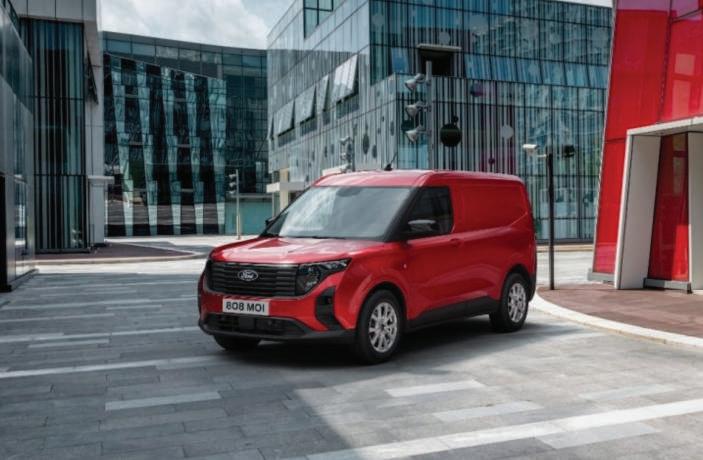
maximum gross payload of up to 854 kg – an increase of over 45 per cent compared with the outgoing model. Maximum towing weight for all variants is 1,100 kg.
All panel vans feature 180-degree opening rear cargo doors and six floor tie-down points as standard. LED loadspace lighting, rubber or wooden floor covers and half-height cargo stowage rails are available to help operators use the load area more efficiently.
Customers can also choose a double-cabin-van body style to carry a work crew as well as their equipment. The double-cab-in-van features a three-seat second row with 60/40 split that can fold and tumble; with the rear seats up, there is space for a Euro pallet in the load area. Pop-out second row windows and glazed rear cargo doors are standard; full side glazing is optional.
Cabin designed around customers’ productivity
Transit Courier’s high level of built-in technology is headlined by a “digiboard” instrument panel containing a digital instrument cluster and eight-inch centre touchscreen with Ford’s latest SYNC 4 connectivity system. 5 Subscription-based Connected Navigation 6 can boost productivity and reduce driver workload with updates on traffic, parking and local hazards. Wireless Android Auto and Apple CarPlay compatibility is standard.
The onboard connectivity is powered by a built-in modem as standard, enabling always-on connectivity with the Ford Pro ecosystem and wireless software updates that can evolve the vehicle’s capability over time without requiring a dealer visit.

For drivers who need regular access to their smartphone, a built-in dashboard phone mounting fin is standard on all Transit Courier vans. This removes the need for a vent or windscreen mount and keeps the phone in a safe but visible location.
New in-cab storage solutions keep the paperwork, devices and cables necessary for a day’s work organised. Drivers benefit from easy-access open storage behind the digiboard and above the glovebox as well as storage for tablets or A4 pads in the centre console. The door bin inserts feature a separator and a holder large enough for 1.5-litre bottles.
The all-new Transit Courier introduces a 125 PS variant 11 of Ford’s efficient 1.0-litre EcoBoost petrol engine, offered alongside the 100 PS version 11 of the same engine, which has been optimised to produce less CO2 and improve fuel efficiency in comparison to previous models.
The EcoBoost powertrain is paired with a six-speed manual gearbox, or a new seven-speed dual clutch transmission to support customers who often drive in stop-start traffic. The system’s twin gearsets enable smooth, fast gearshifts with no loss of torque to improve low-speed efficiency and the driving experience.
A 100 PS 1.5-litre EcoBlue diesel engine is available for customers with higher-mileage use cases. The engine is available on the Transit Courier van and double-cab-in-van models.

